THE AIRPORTS
ROCKY MOUNTAIN REGION
DENVER-STAPLETON INTERNATIONAL AIRPORT
DEN
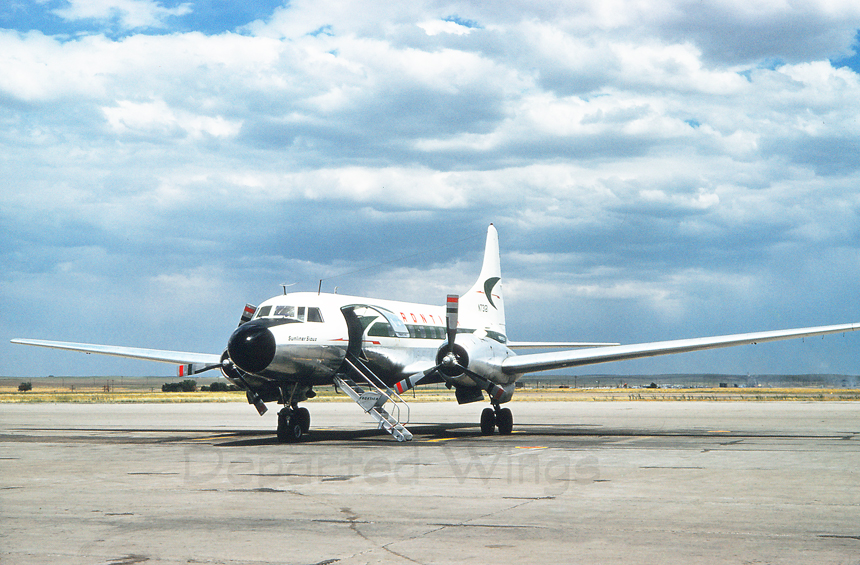
| June
1959 Formed in 1950 with the merger of three local airlines, Frontier Airlines called Denver home and was the airlines base of operations. Originally with a fleet of Douglas DC-3s, Frontier purchased second-hand Convair CV-340 aircraft from United Air Lines in 1959 to provide pressurized and faster service across the Rockies. Parked on the ramp a month before inaugurating "340" service is N73121 "Sunliner Sioux," a Convair CV-340-31. |
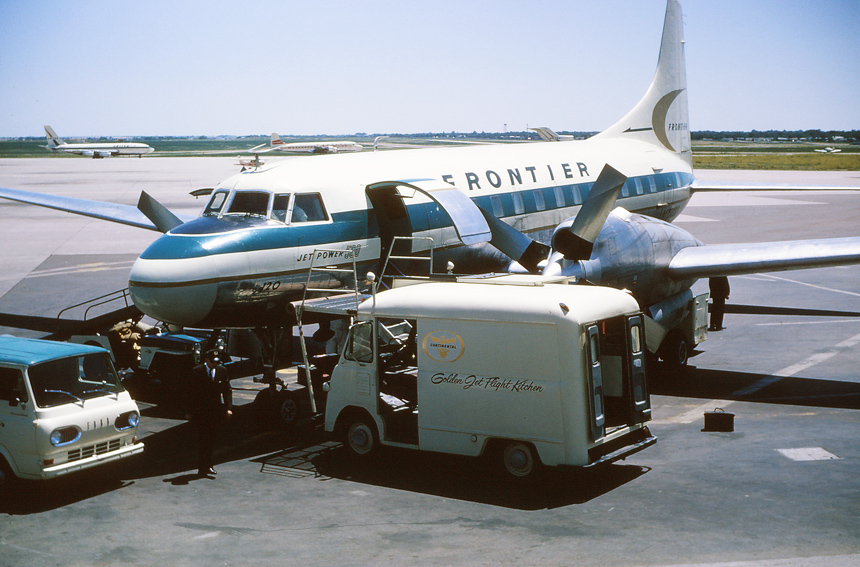
| June
1965 Frontier Airlines was the first airline to operate the Allison turboprop conversion of the Convair CV-340/440 airframe known as the Convair 580 which was introduced in 1964. The powerful turboprop engines made the Rocky Mountain flying and high altitude airports Frontier flew to a safer and more efficient option. Parked on the ramp and being serviced for another regional flight is N73120, a Convair 580 converted by Frontier from an ex-United Airlines Convair CV-340-31. |
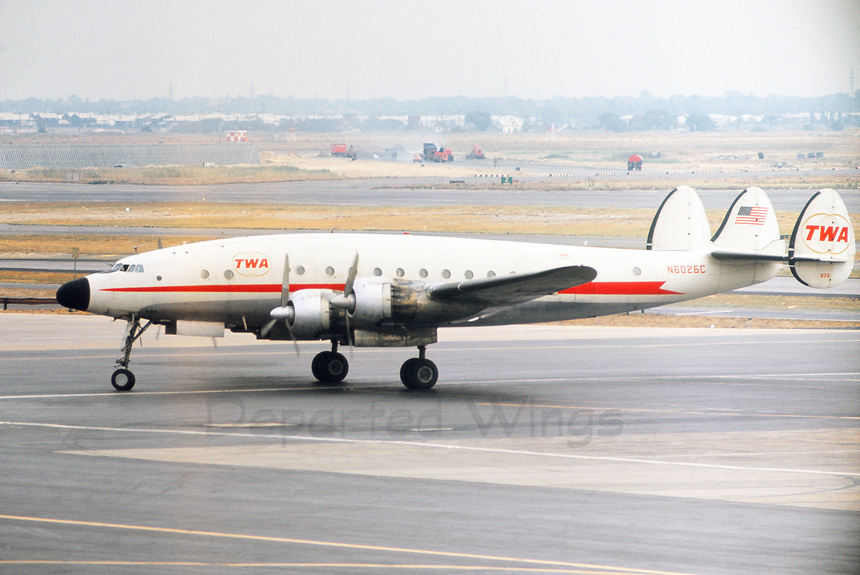
| October
1965 Trans World Airlines (TWA) pioneered the commercial use of the now famous Lockheed L-049 Constellation, when the first was delivered in April 1944. TWA started regular trans-Atlantic service with the Constellation on February 6, 1946 from New York-Idyllwild to Paris. TWA was also first to start non-stop transcontinental service between New York and Los Angeles in October 1953, using the Lockheed Constellation. By the 1960s with the introduction of Boeing 707 jets, the use of the "Connie" declined. At its peak, TWA was operating 156 Lockheed Constellations and Denver still saw service to both Chicago and Kansas City with the planes through the mid-60s until 1967 when the last one was withdrawn from service. Seen starting its radial engines and taxiing away from the terminal ramp is N6026C, a Lockheed L-749A Constellation. |
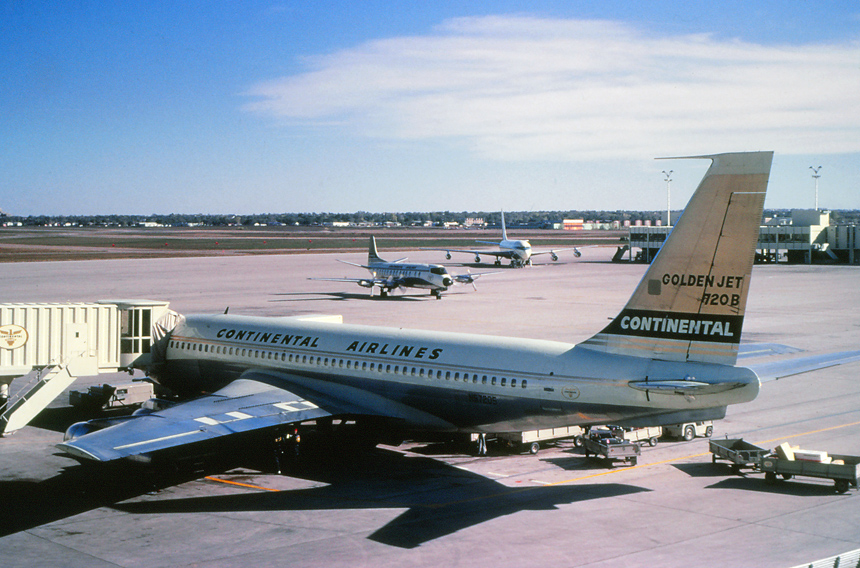
| October 1965 Continental Airlines placed the lighter, medium-ranged Boeing 720 in service during May 1962, to supplement its existing Boeing 707 operations. Early service with the 720 "Golden Jet" was between California and Chicago and Dallas, with eventual services between cities in the Southwest including Denver, Phoenix, and Tucson. Parked at the gate and awaiting passengers is N57205, a Boeing 720-024B, delivered new to the airline in May 1963. |
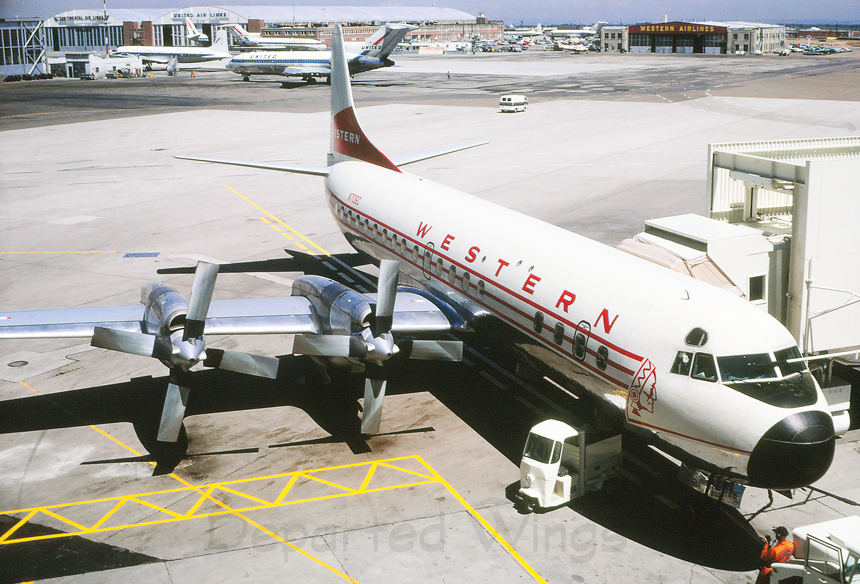
| August
1967 Western Airlines had a long relationship with the Denver region, as predecessor Western Air Express was one of the first airlines to serve the city in the 1920s. Through the 1950s, Western Airlines flew to only two cities from Denver; Cheyenne, Wyoming and Minneapolis-St. Paul, Minnesota using Douglas DC-3s and Douglas DC-4s. Western introduced its first "jet" the Lockheed Electra "turboprop" on August 1, 1959. During the 1960s the Electras' were used on service from Denver to San Francisco and Phoenix. Seen parked at the gate and being readied for an afternoon departure is N7136C, a Lockheed L-188P Electra, delivered new to the airline on July 10, 1959. |
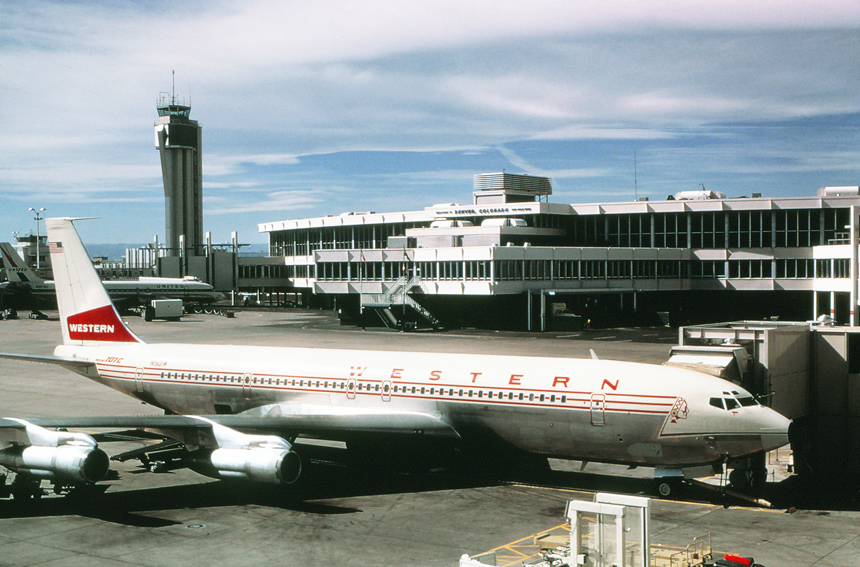
| July
1968 With the introduction of jet service in 1960, Western Airlines continued to expand at Denver and by 1968 had flights to Phoenix, San Francisco, Salt Lake City, Rapid City, and Sioux Falls using either the Boeing 707 or Boeing 720. Parked at the gate and awaiting a turnaround at Concourse C is N1501W, a Boeing 707-347C delivered new to the airline in June 1968. |

|
September
1968 Denver based Frontier Airlines decided to place an order for five Boeing 727-100 series aircraft in 1965 for use on longer proposed routes and busier trunk lines. The first Boeing 727, known as "Arrow Jets," was delivered to the airline in September 1966, and placed on services from Denver to St. Louis, Colorado Springs, and Salt Lake City. Seen rolling out on Runway 26 in reverse thrust is N7272F, a Boeing 727-191, delivered new to the airline on April 19, 1967. |

| February 1970 St. Louis based regional airline Ozark Airlines had operations centered around the upper Mississippi Valley and flew to many secondary cities in Illinois, Missouri and Iowa. The airline received permission to start service to Denver in 1966, which would be the furthest western airport the airline would fly to at the time. Ozark's new Douglas DC-9 was placed on a Chicago-Sioux City-Denver routing which gave travelers another option of service to the "Windy City." Taxiing away from the terminal complex form an eastbound flight is N982PS, a Douglas DC-9-31, originally delivered to Pacific Southwest Airlines (PSA) in 1968, and acquired by Ozark Airlines a year later. |
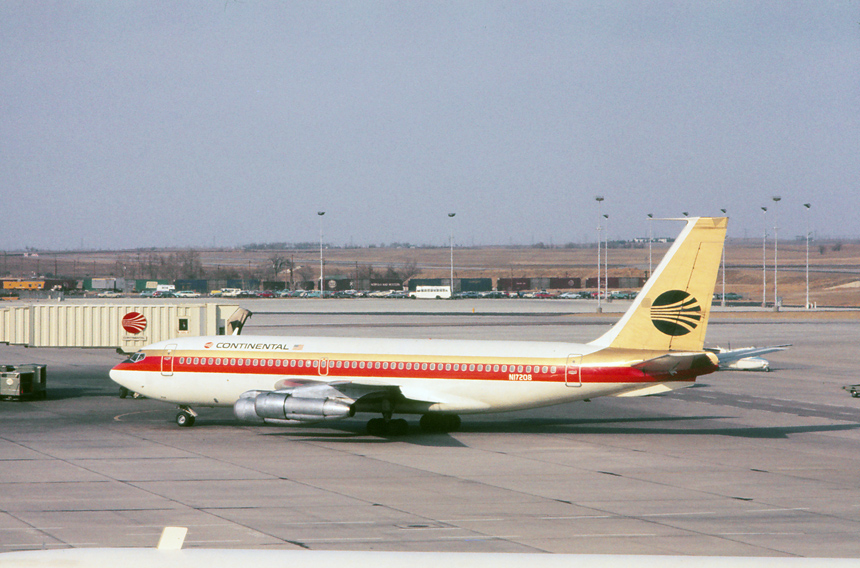
| February
1970 Continental Airlines introduced a new "brand" in 1968 using designer Saul Bass to create a corporate image introducing the airline to the "Jet Age." A new stylized oval representing a jet aircraft in flight; "Jetstream" would adorn everything from timetables and stationary to the golden tails of Continental's aircraft for which the airline was known. Pulling into the gate at Concourse C is N17208, a Boeing 720-024B. |
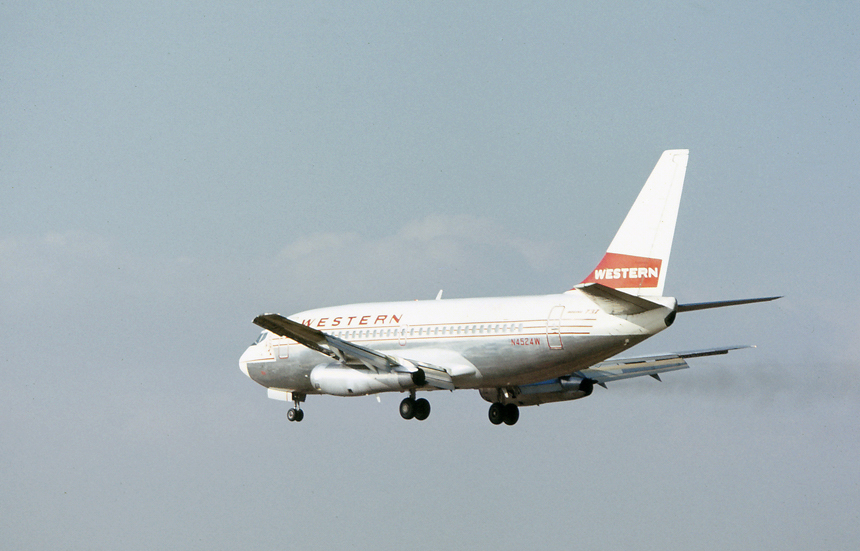
| November
1970 Western Airlines received its first Boeing 737 in 1968 and would use the plane on short haul routes between major cities and secondary destinations. Denver saw the Boeing 737 initially used on routes to Rapid City, Sioux Falls, Cheyenne, and Salt Lake City. Seen high over the numbers for landing on Runway 26 Left is N4524W, a Boeing 737-247, delivered new to the airline in March 1969. |
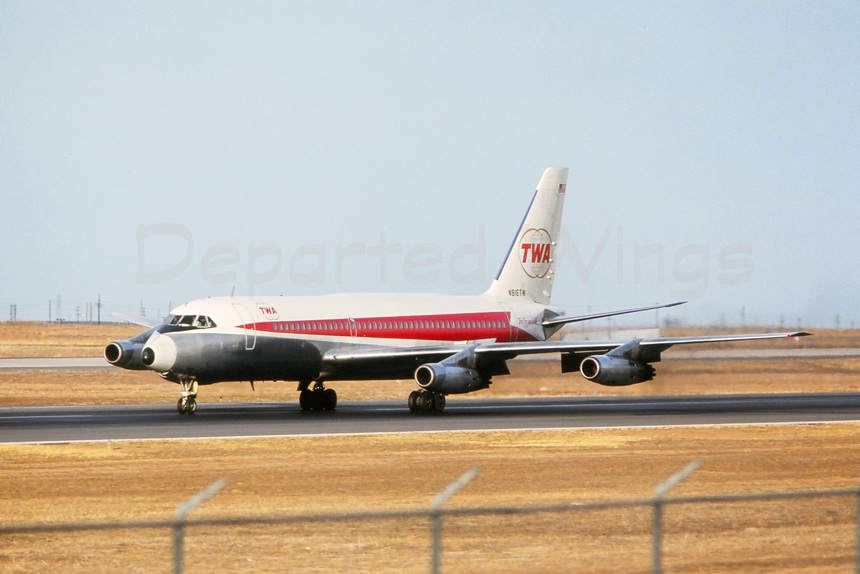
| March
1971 Trans World Airlines (TWA) was the launch customer of the Convair 880 ordering sixty-two of the aircraft however received only thirty of them. San Diego, California based Convair was well known for military aircraft and their propeller driven Convair CV-240, 340, and 440 airframes, wanted to enter the passenger jet market and designed the Convair CV-880. With a smaller capacity then the popular Boeing 707 and a top speed 600 miles an hour, majority shareholder in TWA Howard Hughes wanted the fastest plane at the time, and hence looked toward Convair. TWA's first Convair 880 entered service on January 12, 1961 and was placed on routes across the airline's network. Denver saw the Convair CV-880 on flights to both Chicago-O'Hare and St. Louis. Seen rolling out on Runway 26 Left during an afternoon arrival is N816TW, a Convair CV-880-22-1. |
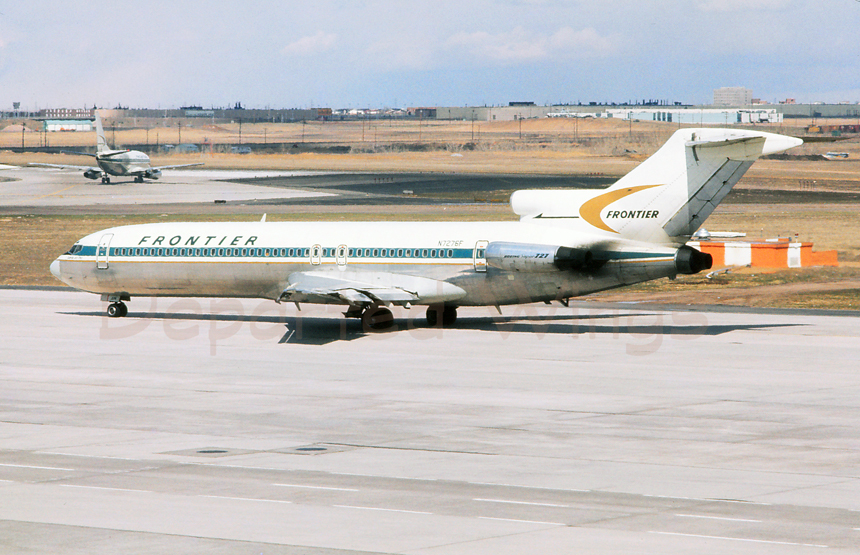
| April
1971 Frontier would eventually acquire five of the Boeing 727-200 series dubbed "Super Jets" in 1966. Eventually the Boeing 727 was seen as too large for the majority of Frontiers routes and were eventually replaced with the Boeing 737-200s by April 1972. Seen taxiing away from the terminal complex enroute to Runway 35 Left is N7276F, a Boeing 727-291. |
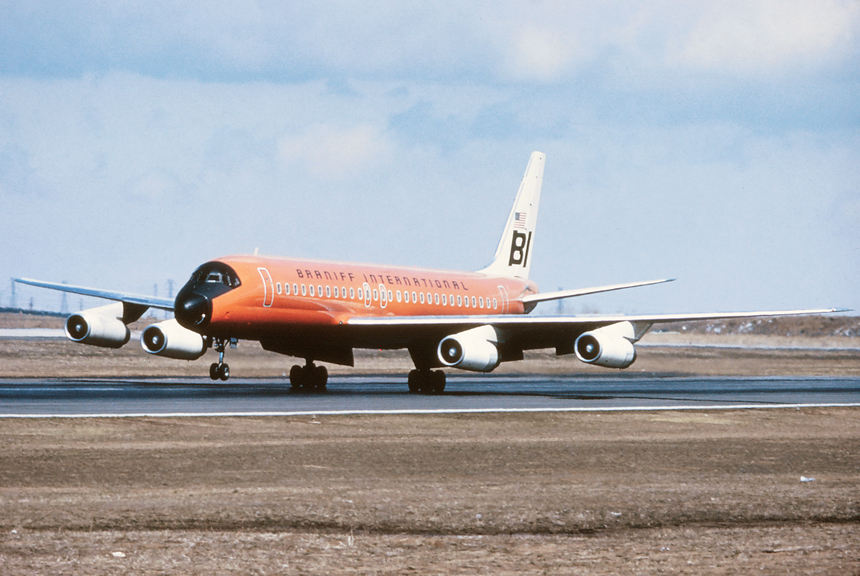
| April
1971 Braniff International Airways had a long history with Denver since its first flights were established in 1943. Braniff became the first U.S. airline to receive the Douglas DC-8 "62-series" when service was started in September 1967. The DC-8 was typically used on schedules to South America however were occasionally used on domestic flights such as between Denver and both Dallas and Houston. Seen just touching down on Runway 26 Left is N1809E, a Douglas DC-8-62, delivered new to the airline in November 1969. |
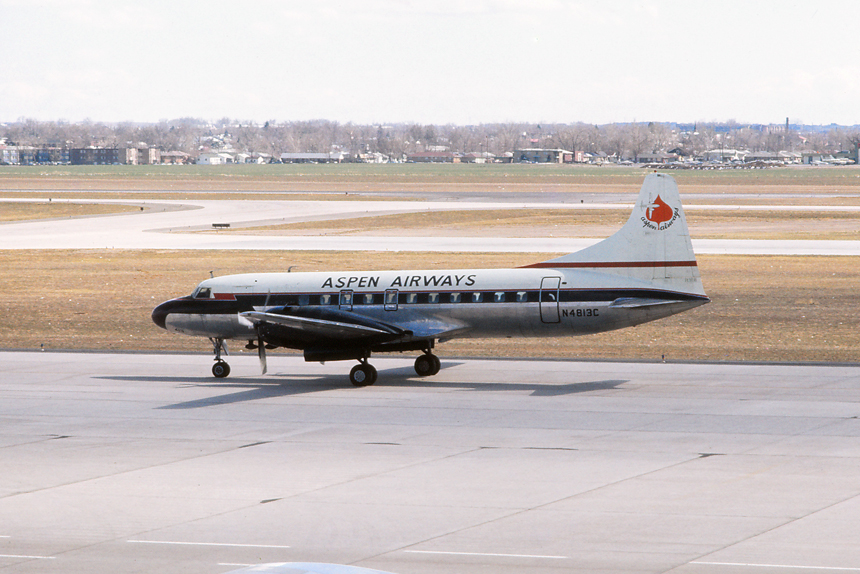
| April
1971 Local "commuter" airline Aspen Airways was established in 1952 to provide "air-shuttle" service between the mountain community of Aspen and Denver. Initially using Douglas DC-3, the airline eventually utilized second-hand Convair piston-engined aircraft for the daily Denver services. Seen taxiing outbound toward the East-West runways for an afternoon departure in N4813C, Convair 340-38, originally with Delta Airlines and purchased by Aspen in March 1970. |
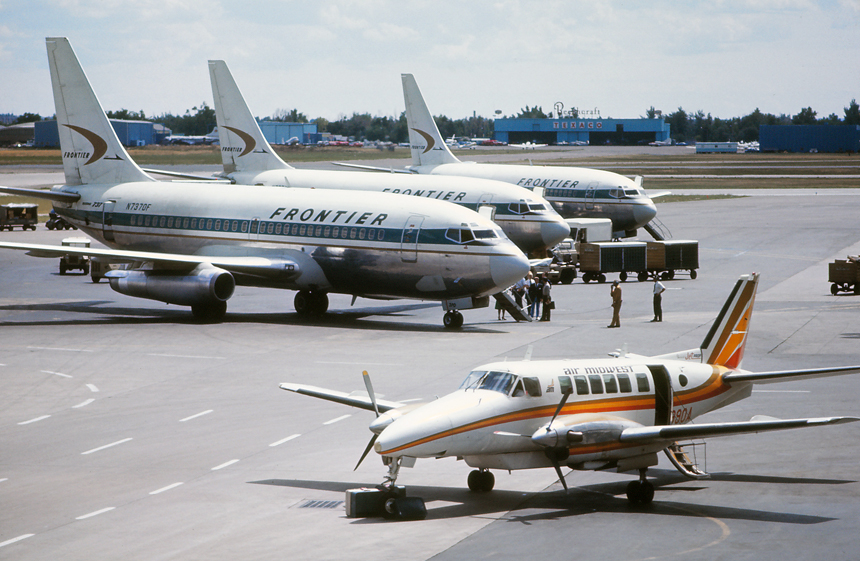
| August
1971 Although Denver was home to Frontier Airlines, many other airlines included commuter airlines had services to the mile-high city. Wichita based Air Midwest, had "commuter" service from Denver east to Garden City and Colby, Kansas using the Beech 99 turboprop. Seen on a busy ramp with a trio of Frontier Airlines Boeing 737s is N3990A, a Beechcraft B-99A. |
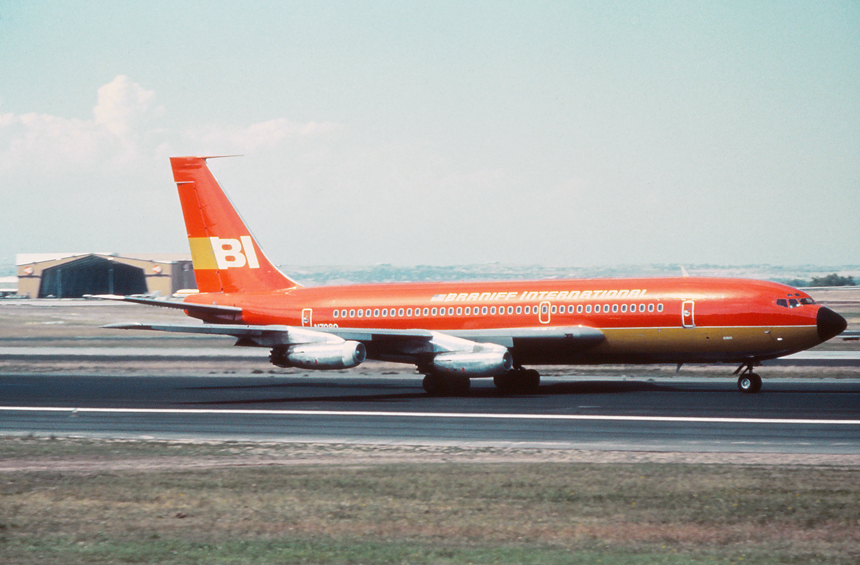
| August
1971 Braniff International Airways entered the "Jet Age" with the delivery of their first Boeing 707 in 1959. Early jet flights connected Dallas, Chicago, and New York. Braniff ordered both the Boeing 707 and 720 to serve both long-range and medium range routings throughout its network. Denver saw the Boeing 707/720 introduced on flights to Dallas in 1963, and continued seeing the four-engined Boeing into the 1970s. Seen about to rotate for takeoff on Runway 8 Right is N7080, a Boeing 720-027 delivered new to the airline in August 1963. |
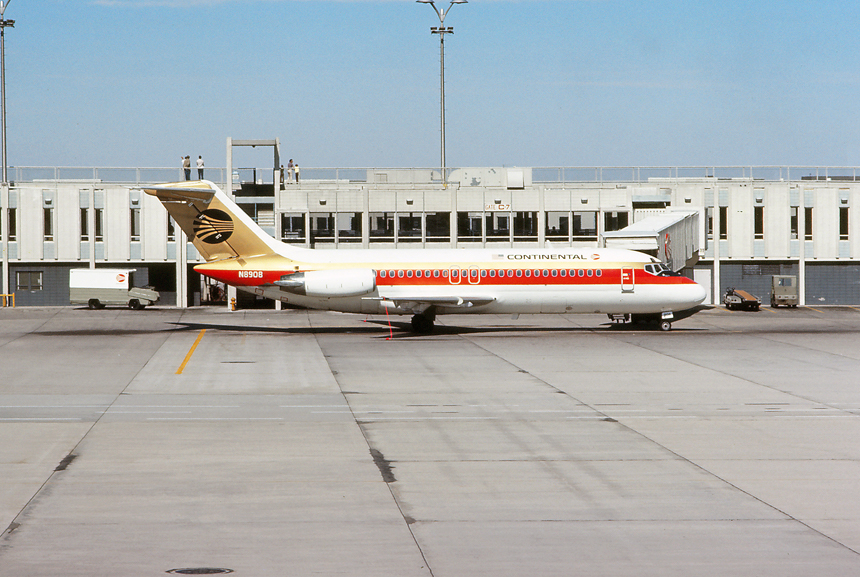
| October
1971 Continental Air Lines launched the "Rapid Change" or "RC" version of the Douglas DC-9 in 1965, with an order for twelve aircraft. The "RC" had the ability to change from passenger configuration to all cargo configuration in about an hour time. Continental was hoping to provide all-freight service during the night hours as a way to maintain maximum utilization of the airplane. The all-cargo service didn't work as planned and Continental used the planes mainly on short-haul segments throughout the system including on flights from Denver to Colorado Springs, Wichita, and Kansas City. Parked at Gate 7 at Concourse C and awaiting preparations for its next flight is N8908, a Douglas DC-9-15RC, delivered to Continental Air Lines in September 1967. |
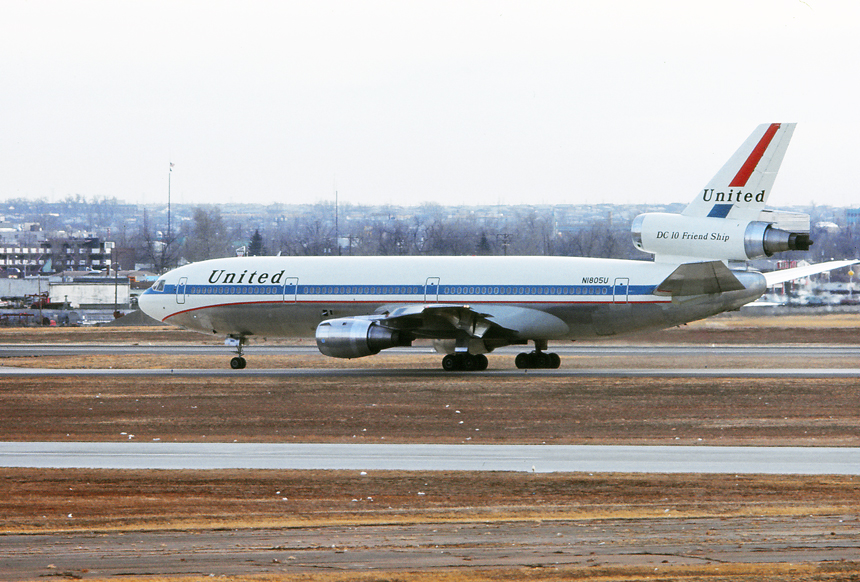
| December 1971 As one of the launch customers for the Douglas DC-10, United Airlines placed an initial order for sixty of the type in 1968. Its first "wide-body" DC-10 was placed into service on July 31, 1971 between San Francisco and Washington D.C.-Dulles. Denver was introduced to the DC-10 "Friendship" a few months later with service to both Chicago-O'Hare and San Francisco. Seen taxiing out for departure on a crisp winter day is N1805U, a Douglas DC-10-10, delivered new to United just a few months early on October 31, 1971. |
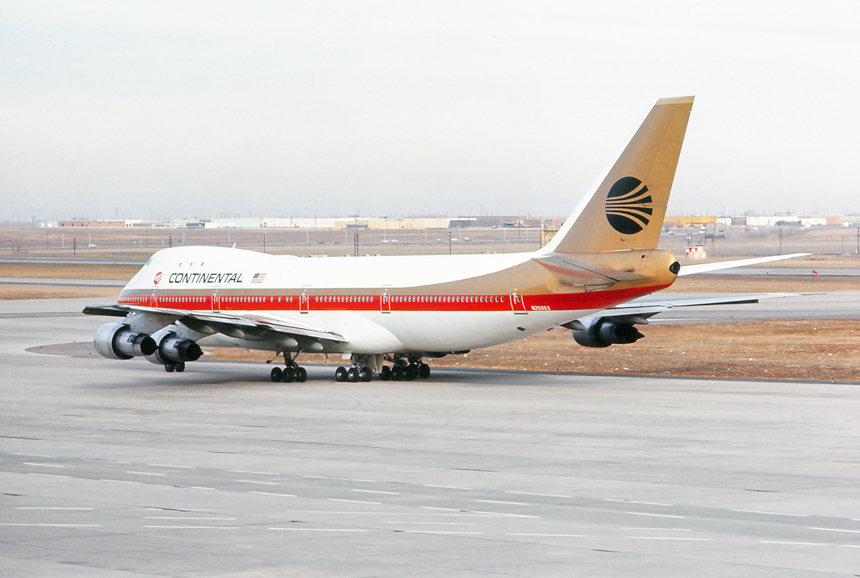
| December 1971 As with many major airlines during the the late 1960s, Continental Airlines placed an order for four of Boeing's new 747 "Jumbo Jets" for use on newly awarded routes to Hawaii. The airlines first Boeing 747 was placed into service on June 26, 1970, on the Chicago-Los Angeles-Honolulu route. Denver saw the Boeing 747 introduced on flights to both Los Angeles and Chicago in November 1970. Seen taxiing toward Runway 35 Left for an afternoon departure is N26863, a Boeing 747-124, delivered new to Continental Airlines on August 12, 1970. |
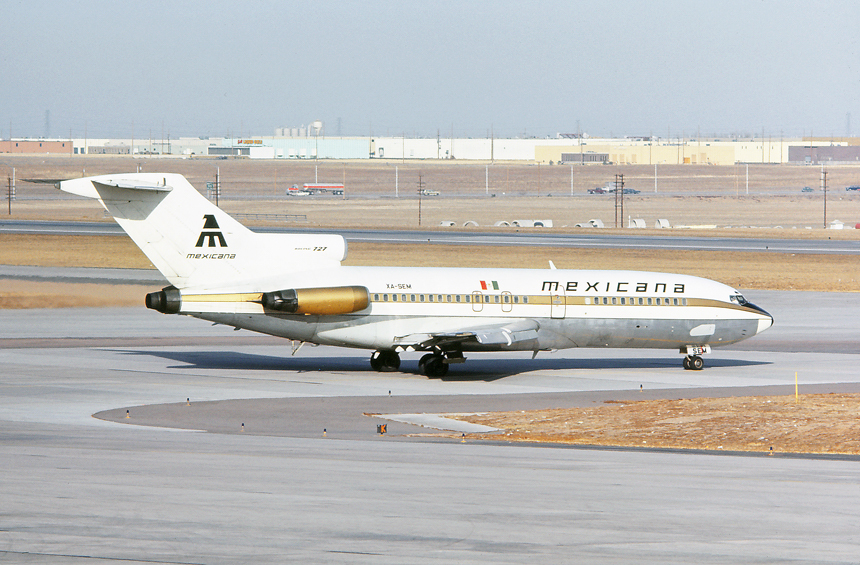
| December 1971 Mexicana Airlines was the first international carrier to start regular service into Denver when non-stop flights were started to Mazatlan during the summer of 1971. The service became popular especially during the winter when the balmy, warm weather of Mexico brought those of Denver south from the snow. Taxiing outbound toward Runway 35 Left is XA-SEM, a Boeing 727-64, originally delivered new to Mexicana in March 1967. |
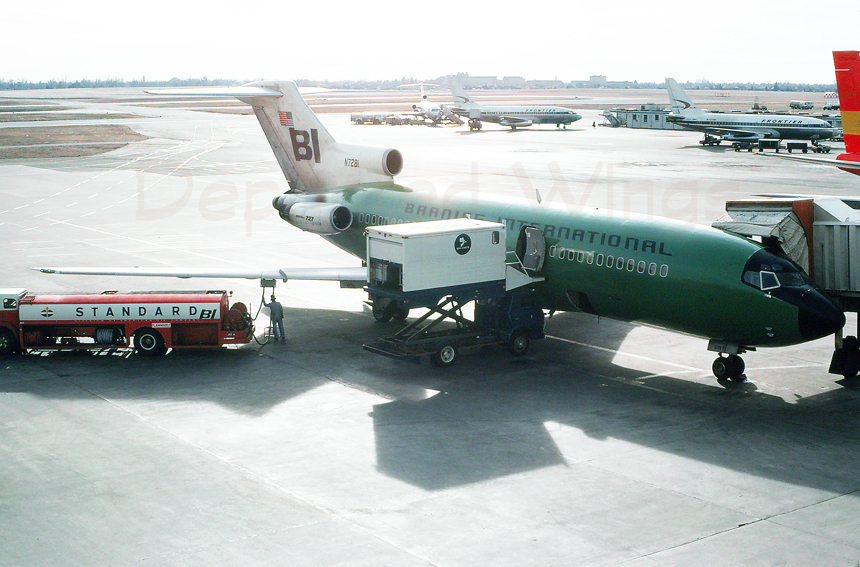
| December
1971 Western Under new direction by Harding Lawrence, Braniff International embarked on a new marketing campaign to lure passengers into the airline growing network. In 1965, having hired Mary Wells to coordinate a new re-imaging of the airline called the "End of the Plain Plane." Wells hired Alexander Giraud to design the images of approximately 17,000 items from the aircraft livery to hand soap packaging. What resulted was an aircraft with bold primary colors, a white tail, and new corporate script. Braniff soon became one of the prominent carriers with a signature image that attracted passengers across the nation. Parked at the gate and wearing the "Panagra Green" colors is N7281, a Boeing 727-27C, delivered new to the airline in April 1967. |
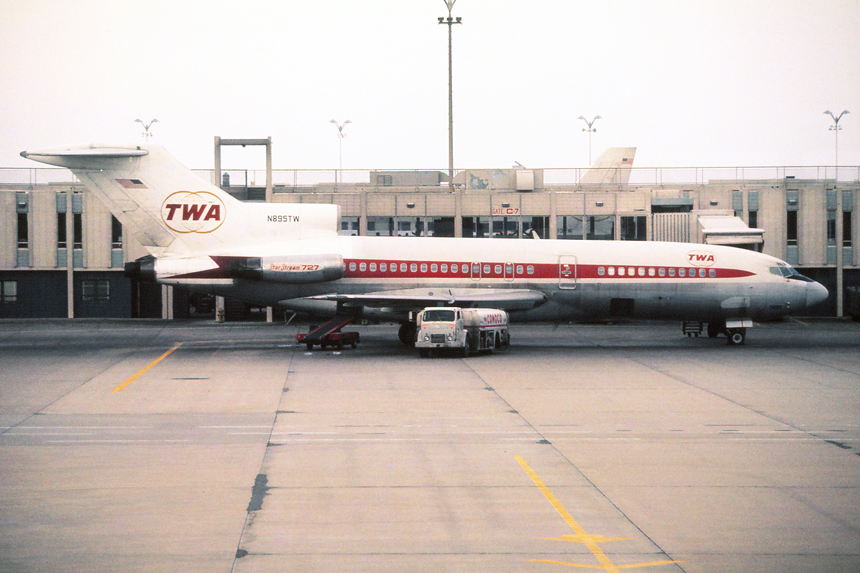
| April 1972 Trans World Airlines (TWA) started service into the Denver area in 1956, with flights to Chicago, San Francisco, and Los Angeles. When TWA started to transition to jet aircraft in 1959, the piston-engined "classics" were soon replaced by more modern Boeing 727 and 707 airplanes. Parked at the gate at Concourse C is N895TW, a Boeing 727-31C, delivered new to the airline in September 1967. |
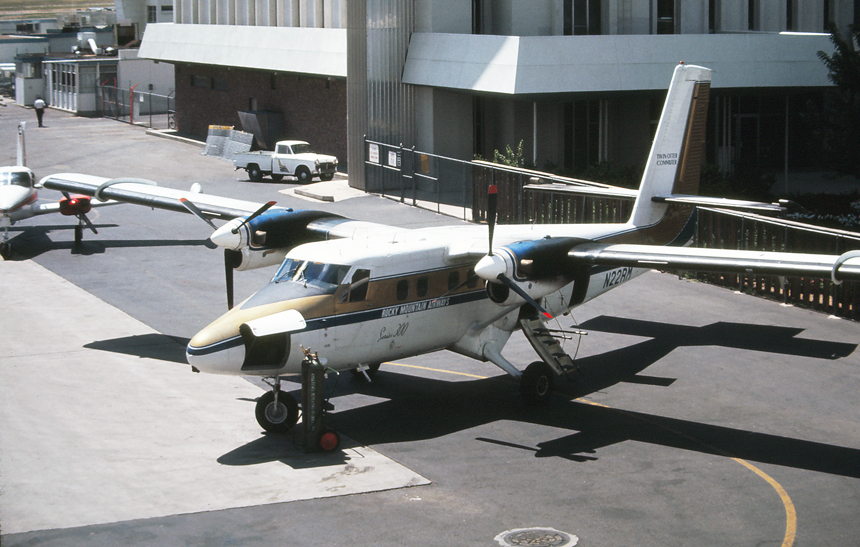
| August 1972 Originally established as Vail Airways in 1963, to provide commuter flights between Denver-Stapleton and Vail-Eagle Airport. With expansion of services to Aspen in 1968, the airline was renamed Rocky Mountain Airways and a year later introduced the de Havilland DHC-6 Twin Otter for passenger service. By 1972, two additional destinations; Leadville and Steamboat Springs were added to the schedule from Denver-Stapleton. Parked at the commuter ramp and being serviced for another flight is N22RM, a de Havilland DHC-6-300. |
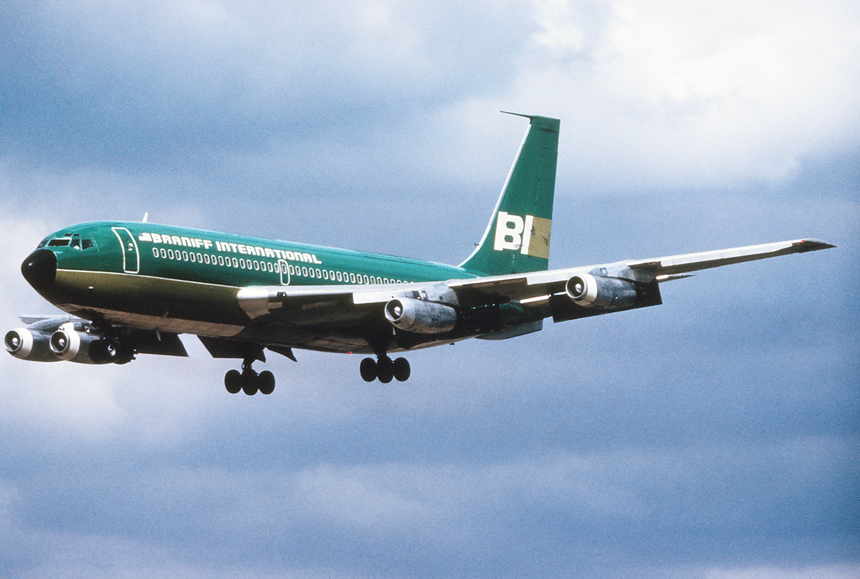
| August 1972 Braniff International Airways bought five Boeing 720 jets in 1960 to replace the aging Lockheed Electra on longer routes in the network as well as for flights to Mexico City. Dubbed "El Dorado Super Jets" when the first aircraft was delivered in January 1961, they remained in service until replaced by the Douglas DC-8 in 1973. Seen on short final to Runway 26 Left is N7079, a Boeing 720-027, delivered new to the airline on May 10, 1962. |
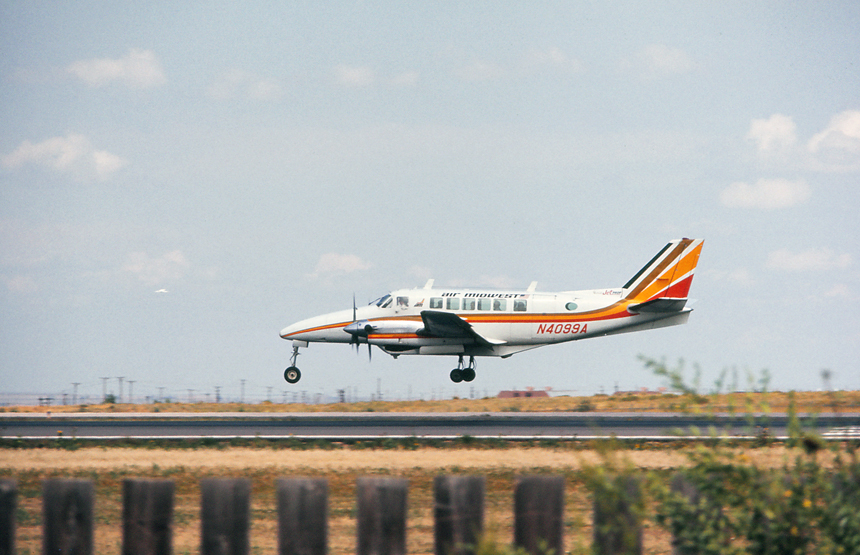
| August 1972 Wichita, Kansas based Air Midwest started operations in 1965 as a charter operator before becoming a commuter carrier in 1969, and placing into service the Beechcraft B-99. As Frontier Airlines started to depart smaller, western Kansas cities and communities, Air Midwest stepped in to resume service and connect passengers to the larger airports. Initial service was from Denver-Stapleton to both Colby and Garden City, Kansas. About to touch-down on Runway 26 Left is N4099A, a Beechcraft B-99A. |
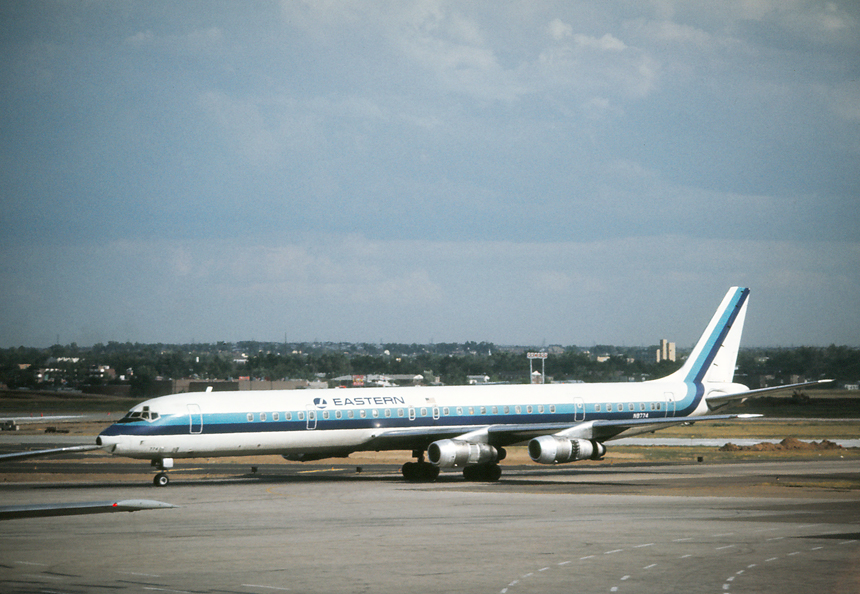
| August 1972 Prior to deregulation, interchange service was a common method that major airlines used to provide connecting services from a joint served airport, yet operated as a "single" route. At a time when the Civil Aeronautics Board (CAB) sometimes took years to determine route cases, these interchange agreements allowed airlines to benefit from markets for which they could use other airlines equipment to continue the service as as their own. Denver had a few interchange agreements, one of the oldest being the Braniff-Eastern interchange established in 1954. A Denver-Memphis-Miami route was established where Braniff crews would fly a Douglas DC-6 from Denver to Memphis, then an Eastern crew would take the aircraft and passengers southeast bound through to Miami. These flights had many intermediate stops in between as established by the CAB route requirements. Once jets were introduced, the Braniff-Eastern Denver interchange services continued however it was now a Denver-Memphis-Atlanta-Miami route using Eastern aircraft. Seen taxiing inbound toward the terminal after having landed is N8774, a Douglas DC-8-61.,. |
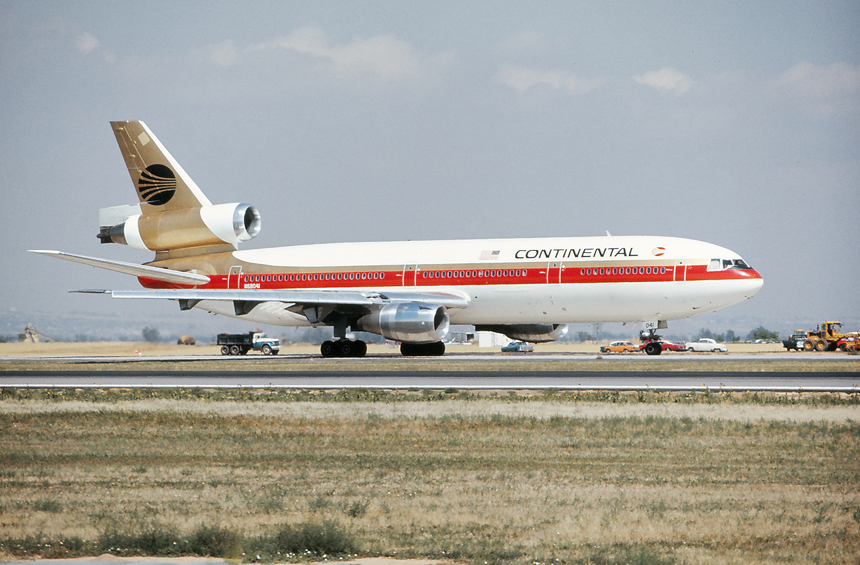
| August 1972 Continental Airlines was the fourth airline to order the new Douglas DC-10 Tri-jet and eventually became the launch customer of the "Convertible Freighter" version ordering eight of the type. With deliveries of the DC-10 starting in 1974, Continental minimized its fleet by only operating two aircraft; the Boeing 727 and Douglas DC-10. The DC-10 was used on medium and long range sectors and the occasional short range-high density routes. Denver saw the Douglas DC-10 initially placed on flight to Chicago, Houston, and Los Angeles. Seen taxiing out to for departure on a warm summer day is N68041, a Douglas DC-10-10, delivered new to the airline just a few months earlier in April 1972. |
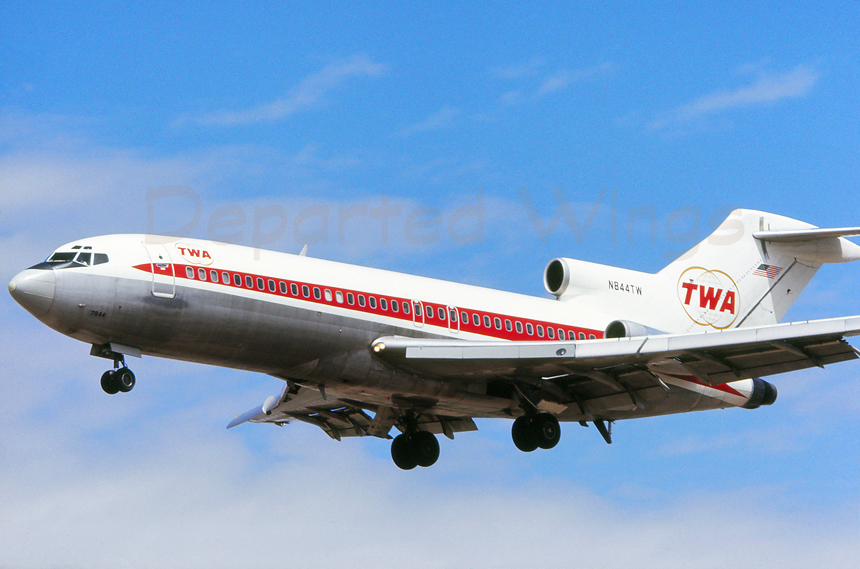
| August
1972 Trans World Airlines (TWA) sought replacement of its piston-engine airline fleet for its short and medium haul market during the early 1960s. At the time, TWA was operating both the Boeing 707 and Convair 880 temporarily assigned to medium and shorter length sectors which became rather uneconomical and reduced aircraft availability on more important trunk routes. The answer was Boeing’s newest tri-jet, the Boeing 727 for which TWA initially ordered ten of the type in March 1962. After delivery, TWA’s first service using the Boeing 727 was started on June 1, 1964 between New York-JFK and Indianapolis. Seen on short final to Runway 26 Left, is N844TW, a Boeing 727-31, delivered new to the airline on November 9, 1964. |
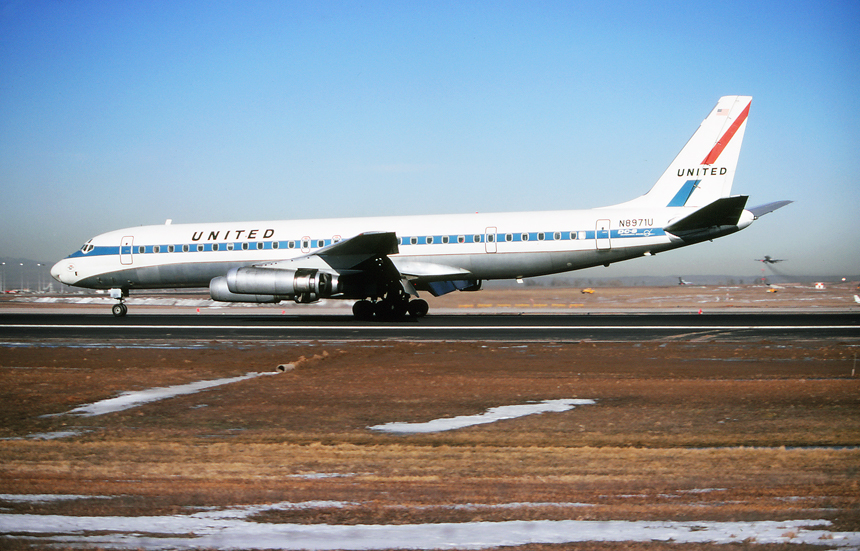
| December 1972 United Air Lines along with Delta Airlines placed the Douglas DC-8 into service on September 18, 1959. United placed the new DC-8 on trans-continental and trans-Pacific flights and as more aircraft were delivered added additional cities saw the new jet. Denver saw the Douglas DC-8 introduced in 1970 on flights to New York and Portland, Oregon. By 1974, the shorter Douglas DC-8 "52s" were used on flights to Newark, New York, Sacramento, Portland, and Seattle. Rolling out on Runway 26 Left during a bright winter afternoon is N8971U, a Douglas DC-8-62H, delivered new to the airline in August 1969. |
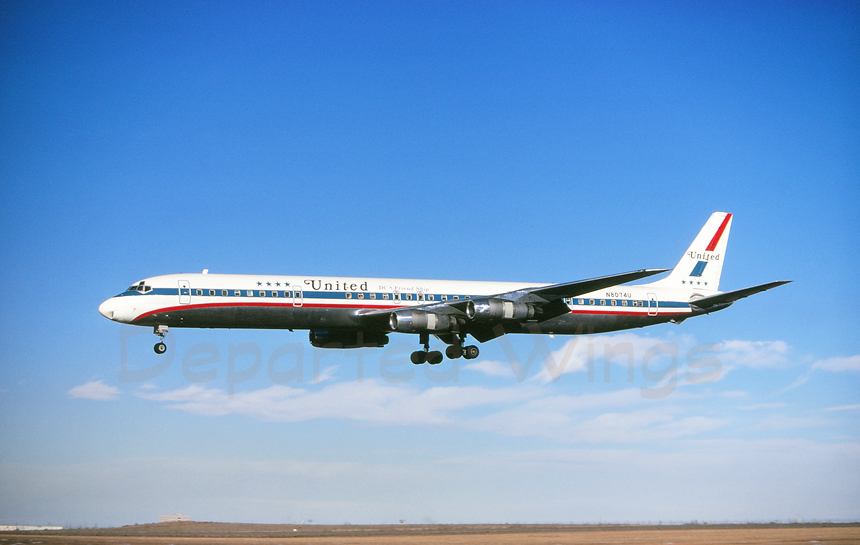
| December 1972 United Airlines placed an initial order for five of the stretched "series-60" version of the Douglas DC-8 in 1965. The addition of a fuselage "plug" ahead of and behind the wings resulted in an additional thirty-three feet added to the aircraft. United had their series-60s configured for 198 passengers, with 26 first class seats and 174 economy seats. The higher capacity aircraft were used on both trans-continental routings as well as trans-Pacific Hawaii services. Seen on short final for landing on Runway 26 Left on a bright winter afternoon is N8074U, a Douglas DC-8-61. |
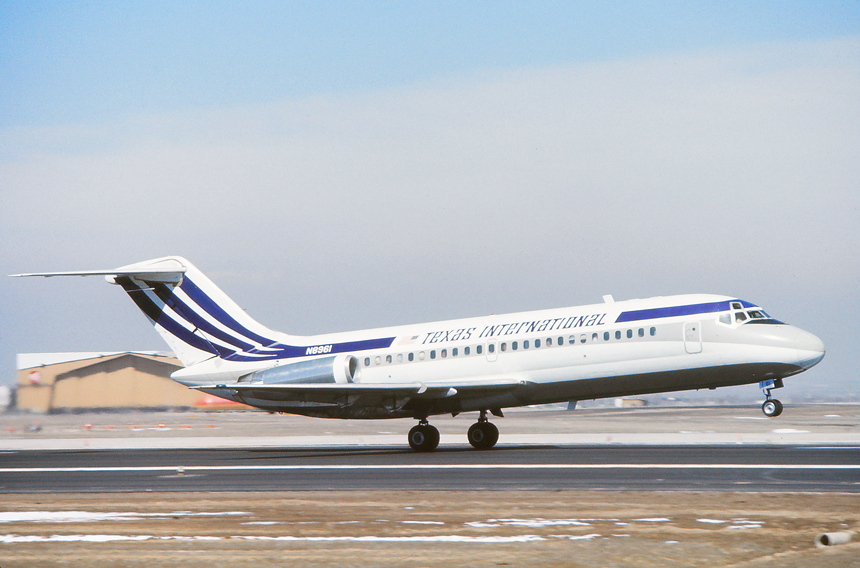
| January
1973 Trans Texas Airways first eighty-seat Douglas DC-9, affectionately known as “Pamper Jets,” were placed into service on October 30, 1966. Jet flights were introduced from both Dallas and Houston to Harlingen and McAllen as well as new international services to Tampico, Monterey, and Vera Cruz, Mexico. The airline expanded rapidly in the next few years so much so that the name was changed to Texas International Airlines in 1968 to better reflect the growing status. By 1970 the airline had expanded westward, adding services to Los Angeles, Denver, and Albuquerque and establishing a loyal following of passengers especially with their discount “Peanuts Fares” and exemplary service. Seen rotating from Runway 8 Right on a cold winter morning, is N8961 “City of San Angelo,” a Douglas DC-9-14, purchased by the airline in May 1969. |
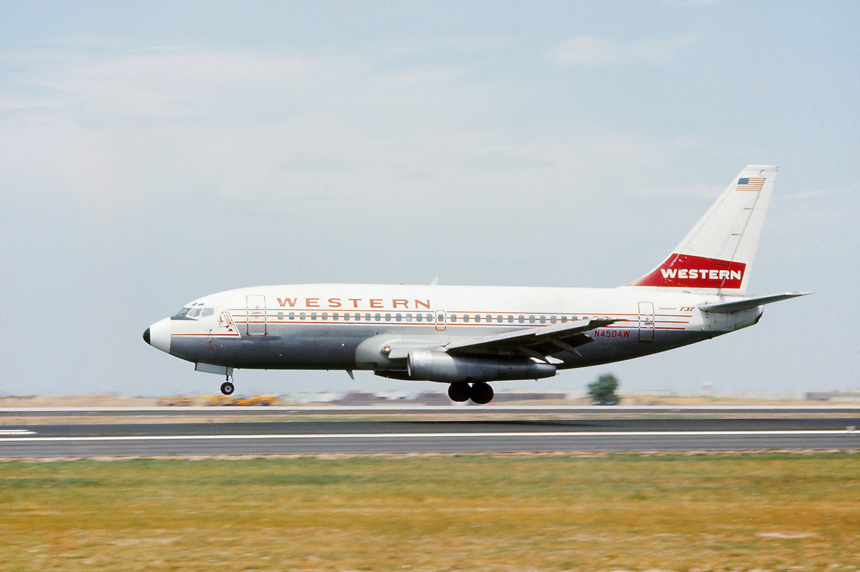
| October 1973 Western Airlines was the first airline to start scheduled international service into Denver when flights were started to Calgary, Canada in December 1968, using the Boeing 737. See about to touch-down on Runway 26 Left is N4504W, a Boeing 737-247, delivered new to the airline on July 17, 1968. |
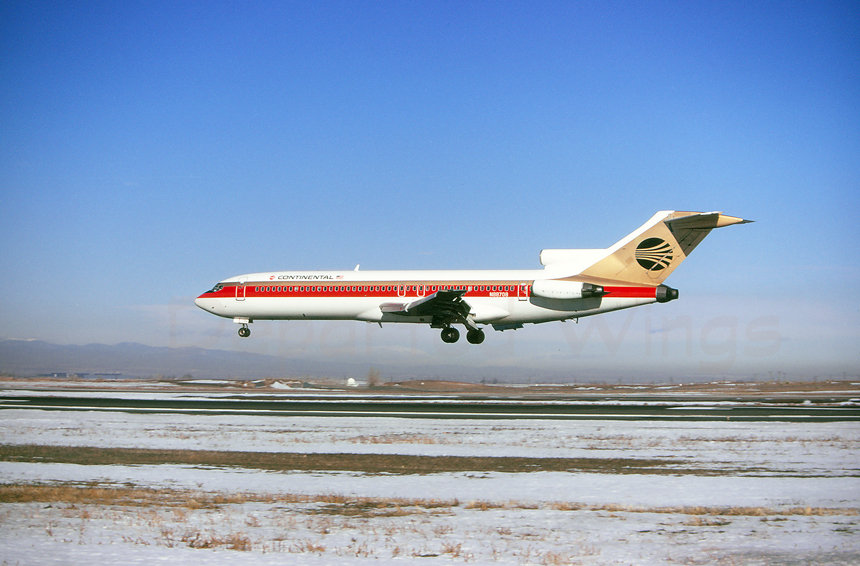
| January 1974 In an effort to lower operating costs and standardize its fleet, Continental Airlines selected the Boeing 727 to operate short and medium range domestic routes and the Douglas DC-10 for heavy domestic and trans-Pacific services. The first of nineteen Boeing 727s was delivered to Continental in 1968, and this would be followed by the "Advanced" -200 series first being delivered in 1973. During the early 1970s, Denver would see over thirty daily departures by Continental Airline utilizing the Boeing 727. Seen "over-the-numbers" for landing on Runway 26 Left on a crisp winter morning is N88708, a Boeing 727-224, delivered in August 1968. |
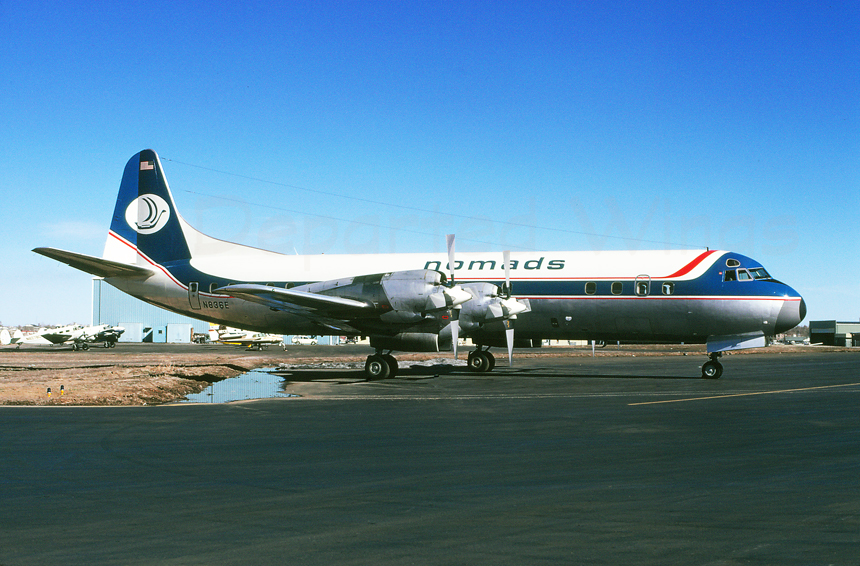
| March 1974 Detroit, Michigan member based travel club Nomads was established in 1965 to provide tour and organized travel packages using its own aircraft. Initial service used a Douglas DC-4, which was replaced with the Lockheed Electra turboprop in 1971. The Electra could be seen throughout the U.S. and Caribbean on member based flights including trips to Denver. Parked at the transient ramp during a member based flight is N836E, a Lockheed L-188-C Electra, originally delivered to QANTAS in 1959 and purchased by Nomads in April 1971. |
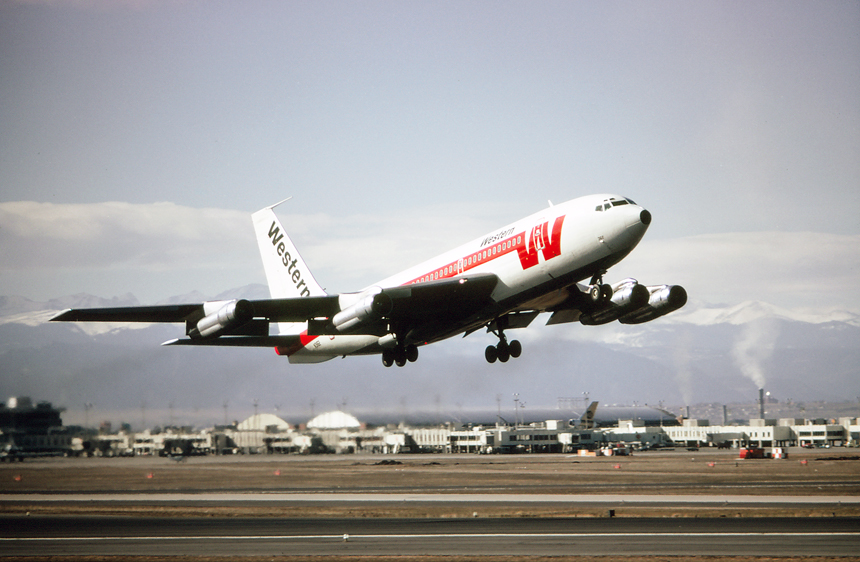
| March 1974 The Boeing 720 was Western Airlines solution for key routes between larger city pairs and international services to Mexico. The first 130-passenger Boeing 720 was delivered in 1961 and placed on longer routes throughout the system. Denver saw the plane placed on flights to Minneapolis-St. Paul as well as West Coast services to Los Angeles, San Francisco, and San Diego. Framed by the Rocky Mountains, N3162, a Boeing 720-047B, is skyward bound from Runway 8 Right. |
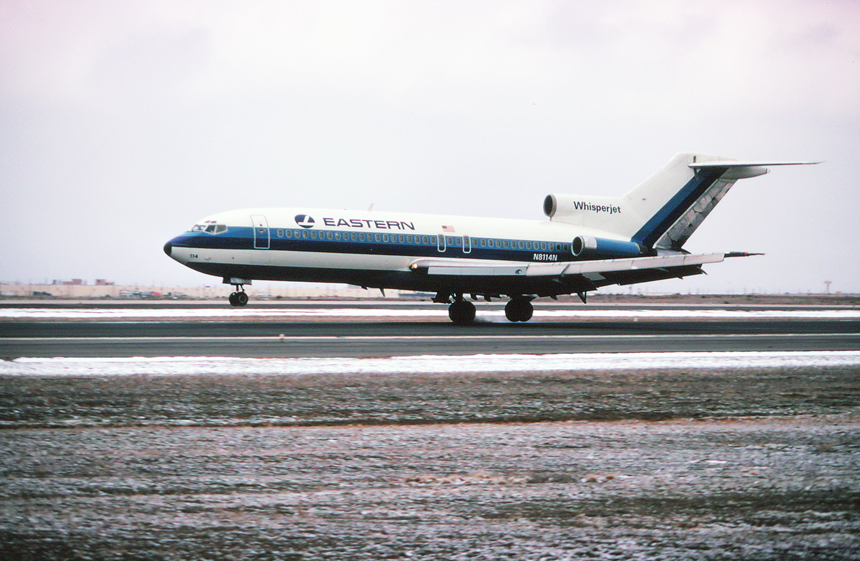
| March 1974 Eastern Airlines and Braniff International Airways continued the interchange agreement that had been forged twenty years earlier. Eastern aircraft continued to be used on the Miami-Atlanta-Memphis-Denver route with the Boeing 727 replacing the Douglas DC-8 on the important service. Seen just touching down on Runway 26 Left during a cold spring afternoon is N8114N, a Boeing 727-25, delivered new to the airline in June 1964. |

| May 1974 After suffering financial loses for a few years, Texas International Airlines was purchased by Jet Capital Corporation in 1972. The airline would continue to operate under its existing name, and returned to profitability with wage cuts and an aggressive marketing campaign. Another change was the unveiling of a new corporate image, with aircraft now painted in the patriotic image of its home state flag of Texas, complete with the "Lone Star" on the tail. Seen in reverse thrust and rolling out on Runway 26 Left is N8961 "The Dallas-Ft. Worth Metroplex," a Douglas DC-9-14, acquired by Texas International in May 1969. |
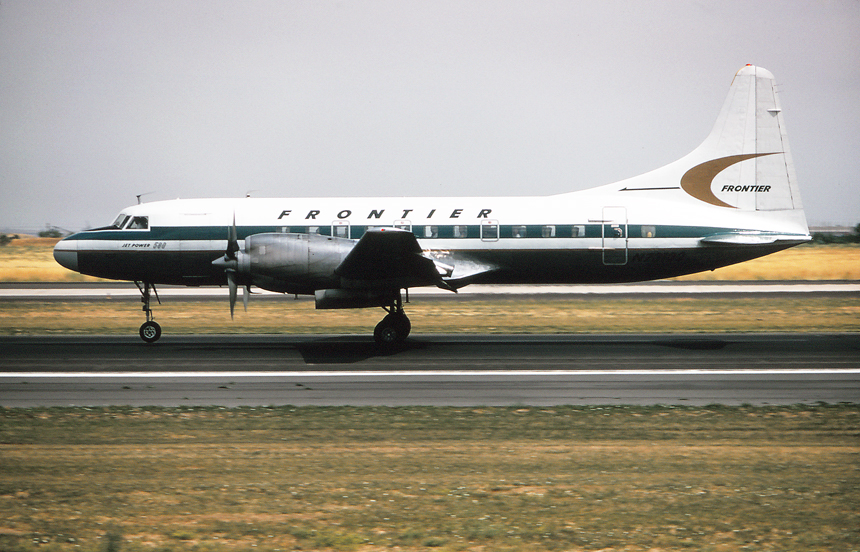
| July
1974 By 1974, Frontier Airlines was operating thirty-three Convair CV-580 turboprop aircraft all having been converted from existing Convair CV-340/CV-440 airframes by the airline. The Convair-580 was the workhorse of the Frontier fleet, flying many regional routes across the rugged Rockies and desert Southwest. From Denver in 1974, the Convair CV-580 was providing eleven daily flights to Colorado Springs, Durango, Grand Junction, and Montrose. Seen rolling for takeoff on Runway 36 Left is N73102, a Convair CV-580, converted from an ex-United Air Lines Convair CV-340 in 1966. |
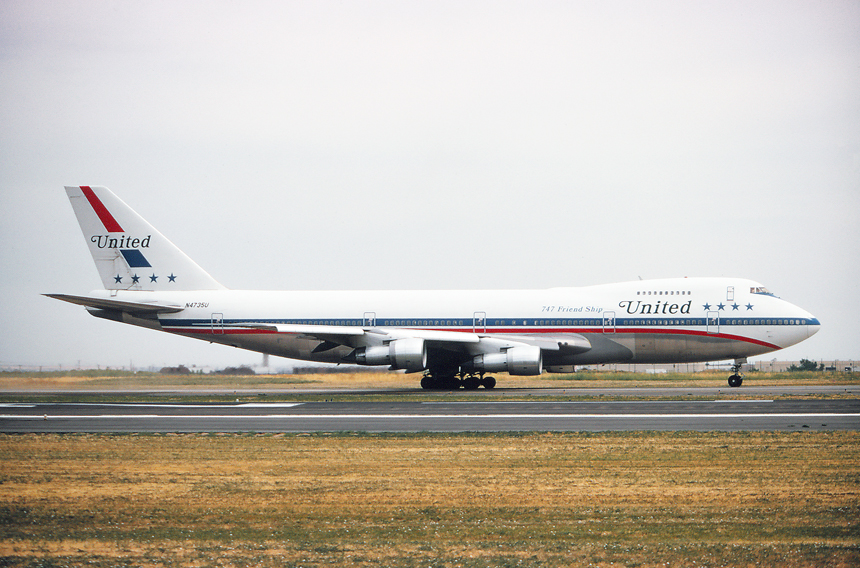
| July 1974 Although Continental Airlines was the first airline to introduce Boeing 747 "Jumbo Jet" service into Denver in December 1970, United Airlines was soon to follow. Flights between Denver and Los Angeles were started in 1974 using the Boeing 747 "Friend Ship." Taxiing out to Runway 26 Left for mid-morning departure is N4753U, a Boeing 747-122, delivered new to United Airlines on May 30, 1973. |
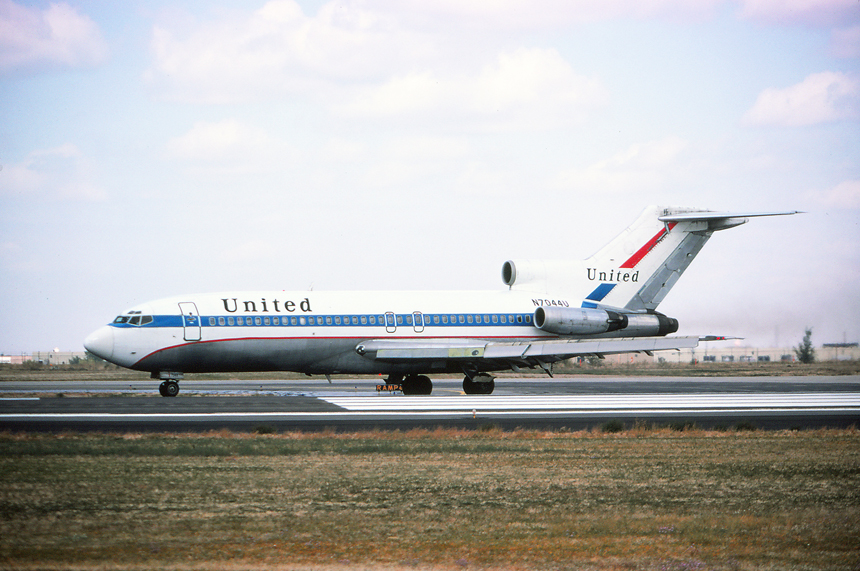
|
September 1974 By the early 1970s, United Airlines had placed the Boeing 727 as its foundational aircraft for short to medium range flights throughout its network. By 1974, United's Boeing 727s were providing no less then one hundred daily departures from Denver to twenty-five cities including Baltimore, Chicago, Detroit, Omaha, San Francisco and Seattle. Turning onto Runway 26 Left for a mid-morning departure is N7044U, a Boeing 727-22, delivered new to the airline in September 1966. |
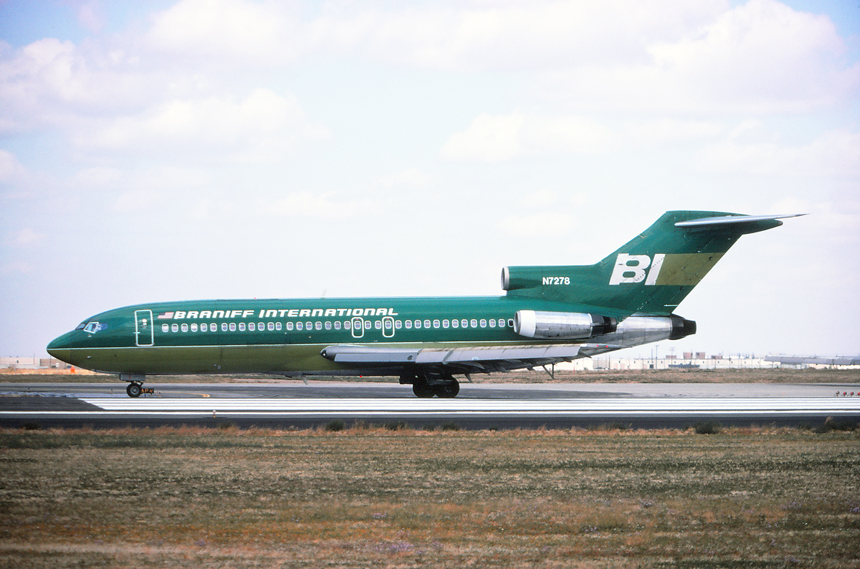
|
September 1974 In 1965, Braniff International Airways ordered twelve Boeing 727-100 "Quick-Change" versions which had the ability to be reconfigured for an all-passenger, all-cargo or "combi" depending on need. Braniff's intent was to use the 727s during the day in all-passenger configuration then swap to all-cargo at night for its new AirGo cargo business. The Boeing 727 eventually replaced the Douglas DC-8 and Boeing 707 on flights to Denver by the mid-1970s. Seen holding in position for takeoff on Runway 26 Left and wearing the green/olive green "Flying Colors," is N7278, a Boeing 727-27C, delivered to the airline in February 1967. |
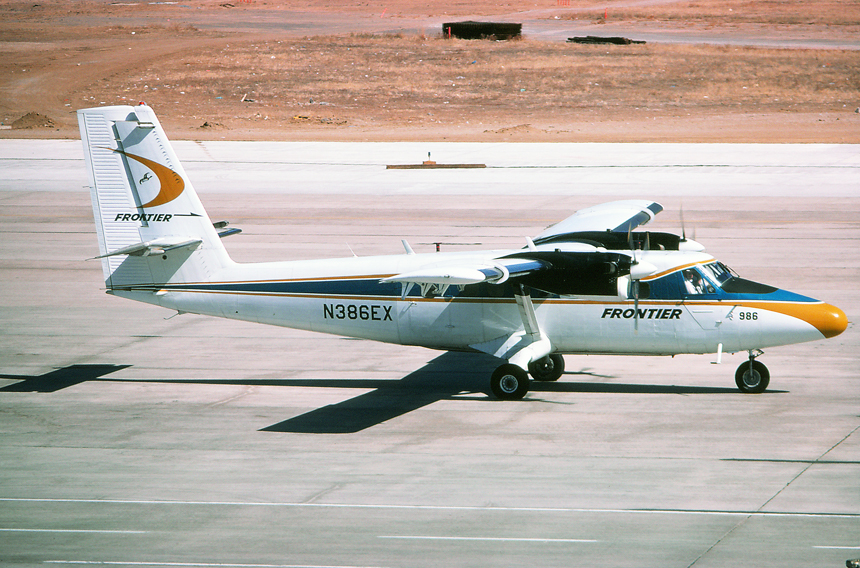
| March
1975 In an effort to provide Essential Air Service to destinations in Montana and western Nebraska which were too small for the Convair CV-580s, Frontier acquired a small fleet of the de Havilland DHC-6, Twin Otters in 1972. The 19-passengers turboprops were used on flights to destinations such as Alliance and Chadron, Nebraska and Wolf Point, Havre, and Lewiston, Montana. Seeing taxiing outbound for departure is N386EX, a de Havilland DHC-6-300 Twin Otter. |
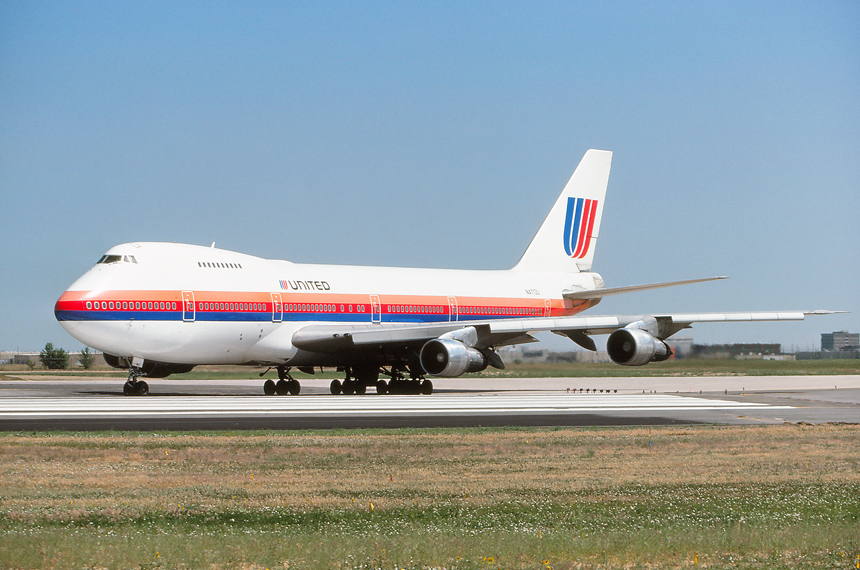
|
July 1975 United Airlines introduced a new corporate logo and color scheme in 1974 designed by legendry graphics designer Saul Bass. The tri-color fuselage stripes and the red and blue tail "Tulip" formed by adjoining "U's" would start appearing on aircraft in June 1975 and create a "New Sprit in the Friendly Skies." Seen turning onto Runway 26 Left for a mid-morning departure is N4713U, a Boeing 747-122 delivered new to the airline in November 1970. this was the same aircraft that suffered an explosive decompression after the right forward cargo door failed over the Pacific Ocean on February 24, 1989, resulting in the deaths of nine passengers. |
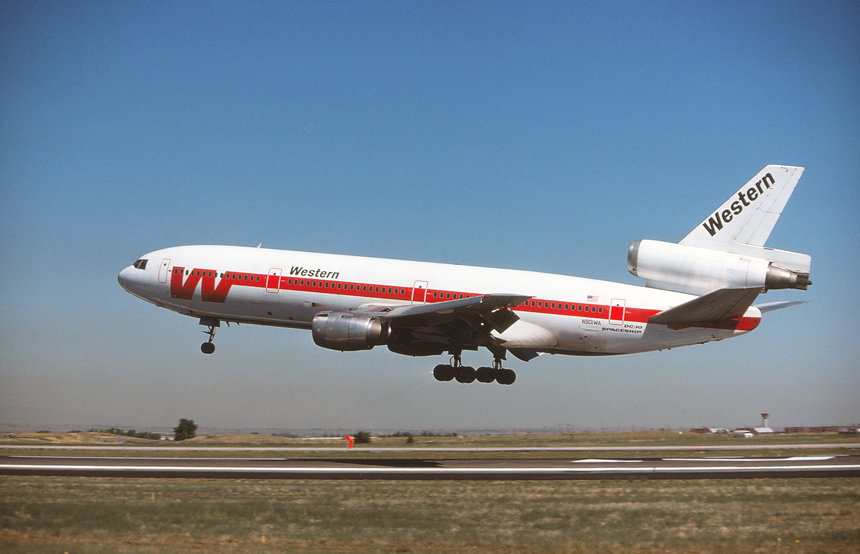
|
August 1975 Western Airlines after receiving approval from the Civil Aeronautics Board (CAB) in 1969 to start service from up to eleven cities on the Mainland to Hawaii, sought a larger capacity aircraft. Although Western had initially chosen the Boeing 747 and placed an order for three aircraft, this fell though and Western placed an early order for four Douglas DC-10s. Dubbed "Spaceships," with a capacity of 239-passengers in a two-class configuration, the airline first wide-body was delivered on April 19, 1973. Although mainly used on Hawaii, Alaska, and Mexico services, the planes were a rare treat at Denver occasionally being substituted on flights to Salt Lake City and San Francisco. Seen in flare for landing on Runway 26 Left is N901WA, a Douglas DC-10-10, and the first aircraft to be delivered to the airline. |
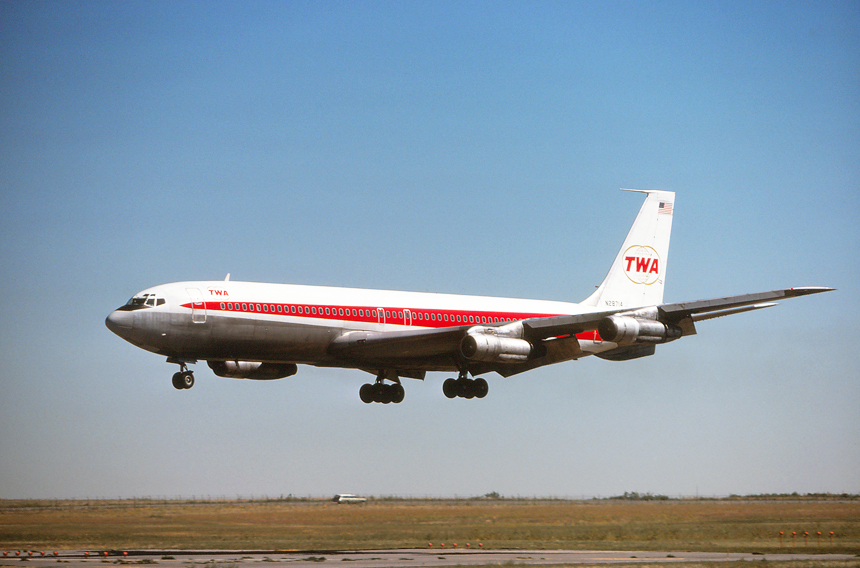
|
August 1975 Trans World Airlines (TWA) placed a $400 million order for its first jet, the Boeing 707 in 1958. Seen as a replacement for the graceful yet aging Lockheed Constellations, the Boeing 707 would bring the airline on par with the other "Big Three" (American, Eastern, and United) which had already introduced jet services. TWA placed its first 707 on its flagship New York-San Francisco route on March 20, 1959. By 1975, TWA's Boeing 707s were seen on daily trunk services from Denver to Boston, Chicago-O'Hare, New York-JFK, and St. Louis. Seen "over-the-numbers" for landing on Runway 26 Left is N28714, a Boeing 707-331B. |

|
October 1975 During the era of aircraft based travel clubs, arguably one of the more famous was Denver based Ports of Call Travel Club which was established in 1966. The membership fee based club initially started using a Douglas DC-7 and both domestic and international flights were scheduled for its members. Turboprop service in the form of the Lockheed Electra was introduced in 1972, increasing capacity, range and comfort for its membership. Parked on the Ports of Call ramp during a fall afternoon is N8355C, a Lockheed L-188 Electra-C. |
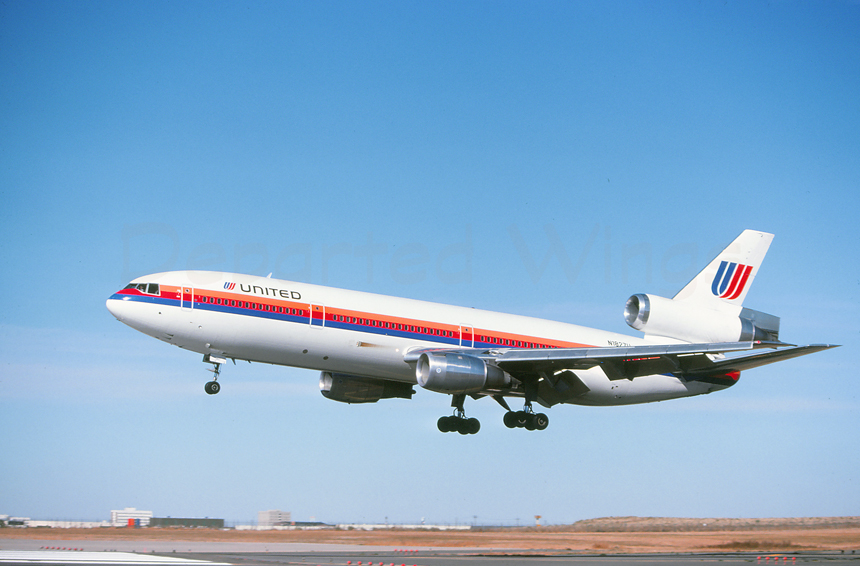
| October 1975 During the mid-1970s, United Airlines Douglas DC-10 with a passenger capacity of 222 in a mixed seating configuration was using their "Heavy 10s." on higher capacity routes from Denver to Chicago-O'Hare, Detroit, Las Vegas, San Francisco, and New York-JFK. Seen "over-the-numbers" for landing on Runway 26 Left on a clear fall afternoon is N1827U, a Douglas DC-10-10, delivered to the airline on April 25, 1975. |
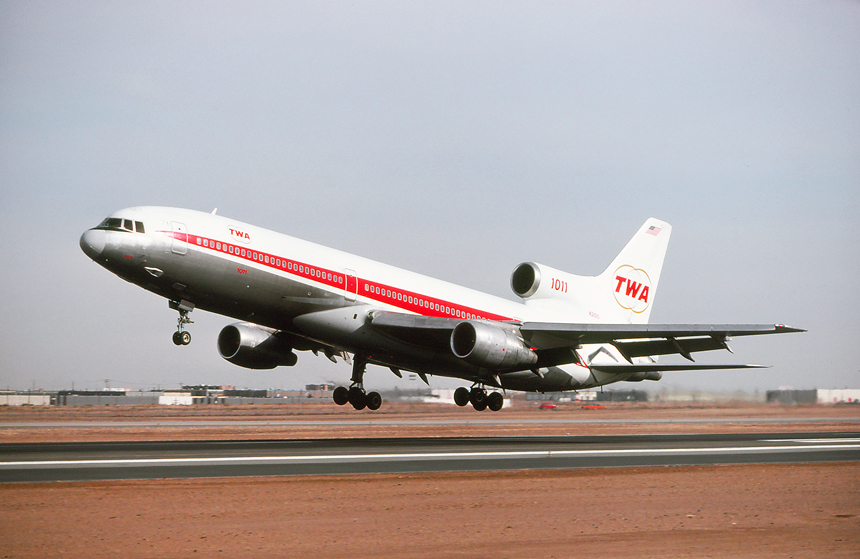
|
January 1976 After the introduction of the Lockheed L-1011 by Trans World Airlines (TWA) on June 25, 1972 the "Tristar" was initially used on trunk routes from the carriers St. Louis hub. With an early configuration of just 206-passengers, TWAs L-1011 were spacious and roomy with both first and economy class lounges. Although not typically deployed on routes to Denver, in the late 1970s the graceful L-1011 was occasionally substituted on winter schedules to both St. Louis and New York-JFK. Seen in flare for touchdown during an afternoon arrival on Runway 26 Left is, N31015, a Lockheed L-1011-1 Tristar. |
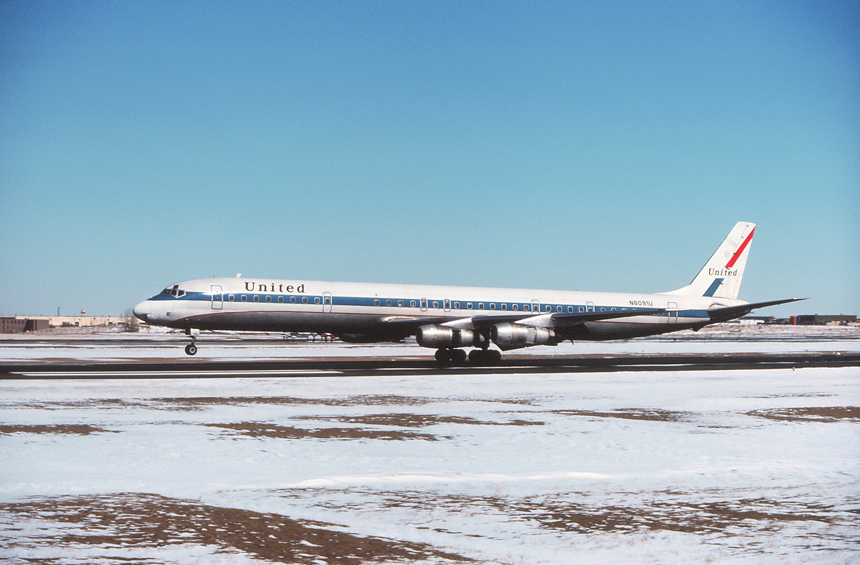
| February
1976 The "stretch" Douglas DC-8 continued to play an important role for United throughout the 1970 and were used on trunk flights from Denver to Chicago-O'Hare and Los Angeles, as well as other routes such as Frenso and Milwaukee. Seen touching down on Runway 26 Left during a cold winter morning is N8091U, a Douglas DC-8-61, delivered new to the airline in September 1968. |
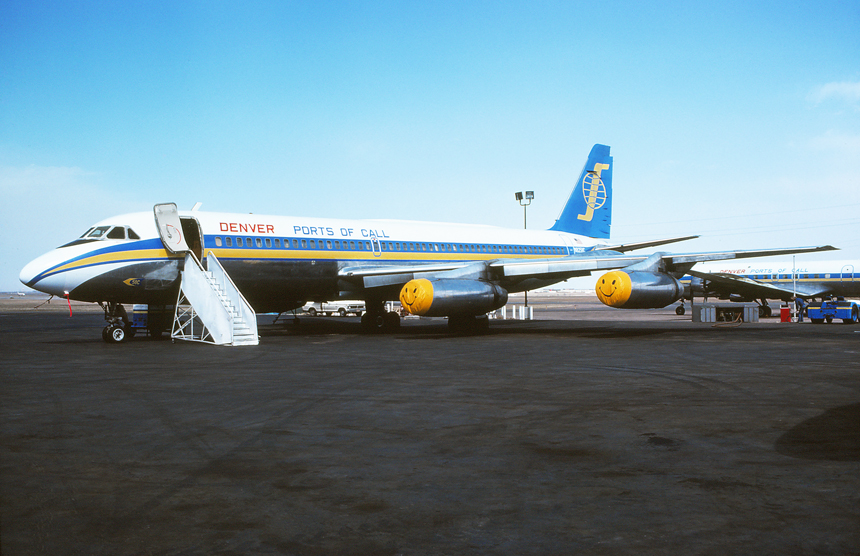
| March
1976 Denver Ports-of-Call received its first pure jet aircraft a Convair 990 in 1975, which increased the range of non-stop flights and capacity for planned member trips. What became a selling point for the club, was the private terminal for its members which provided less hustle and bustle then the Stapleton main terminals. Parked on the ramp and awaiting its next "tour" flight is N8258C, a Convair CV-990A Coronado (30-A). |
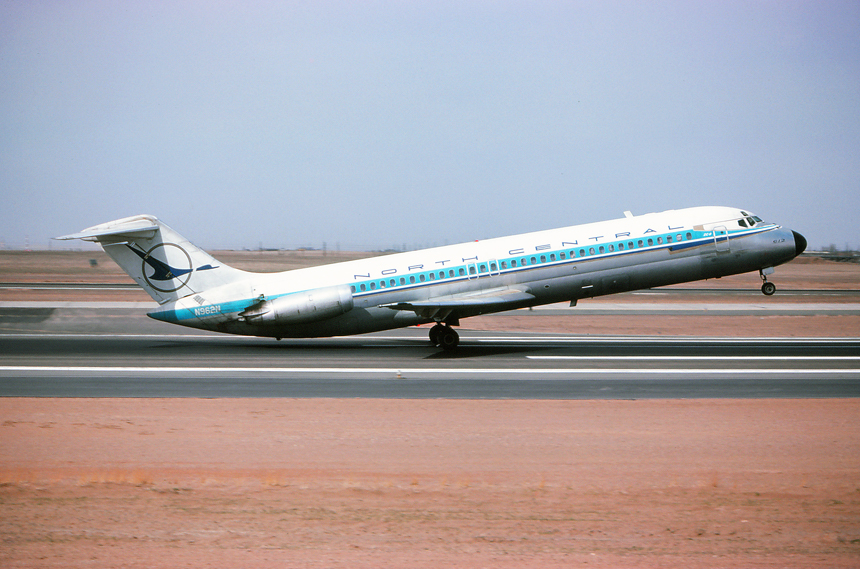
| April
1976 Minneapolis-St. Paul based local service carrier North Central Airlines had centered operations as required around the upper Midwest region with operations focused on Minneapolis-St. Paul, Chicago, and Detroit. In June 1969, the airline was granted permission by the Civil Aeronautics Board (CAB) to start service between Denver and Minneapolis-St. Paul, thus become the furthest destination west served by the airline at the time. Seen rotating for takeoff on Runway 8 Right enroute to Minneapolis-St. Paul is N962N, a Douglas DC-9-31, delivered new to the airline in May 1969. |

|
August 1976 One of the most famous Boeing 707s was that of the two United States Air Force Special Air Mission (SAM) specially modified VC-137C Presidential transports. Designated "Air Force One" when carrying the President of the United States the two aircraft, 27000 and 26000 which were placed into service in October 1962, could be seen world-wide on both diplomatic and humanitarian missions. Seen landing on Runway 26 Left "SAM two-six-thousand," a VC-137C (Boeing 707-353B) visits Denver as a back-up plane to President Carters visit to Vail, Colorado and his primary aircraft used that trip 27000 which was parked at Walker Field in Grand Junction, Colorado. |
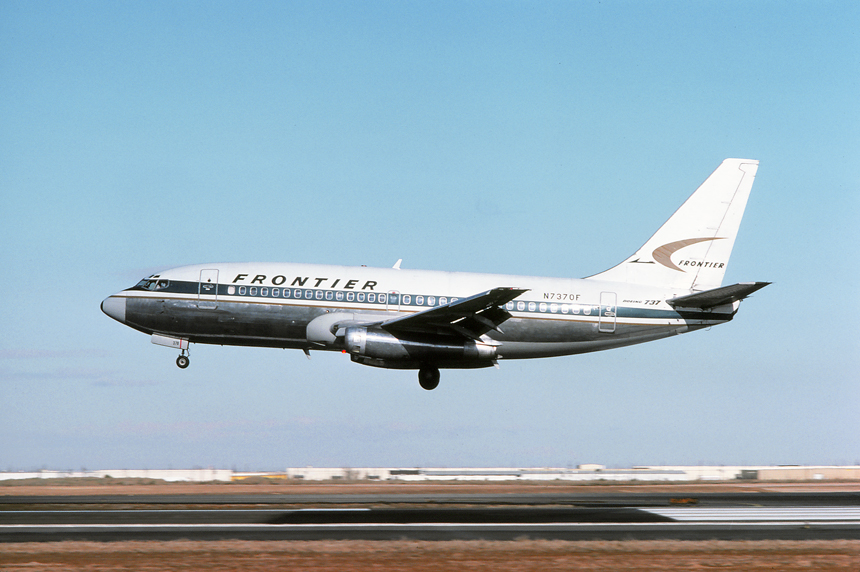
| December
1976 Frontier Airlines had initially introduced the Boeing 727 as the aircraft to usher the airline into the "Jet Age" in 1966. It was soon realized the the Boeing 727 was too large for most of Frontier's routes and the airline made the decision to order the smaller Boeing 737 in 1968. Frontier placed its first Boeing 737 in service in May 1969, and introduced many cities across it's network to "jet" service for the first time. Destinations such as Casper, Grand Junction, and Rapid City welcomed the new Frontier aircraft as a quicker, more efficient means to Denver. Seen "over-the-numbers" for landing on Runway 26 Left on a bright winter morning is N7370F, a Boeing 737-2CO, the second example being delivered to the airline in May 1969. |
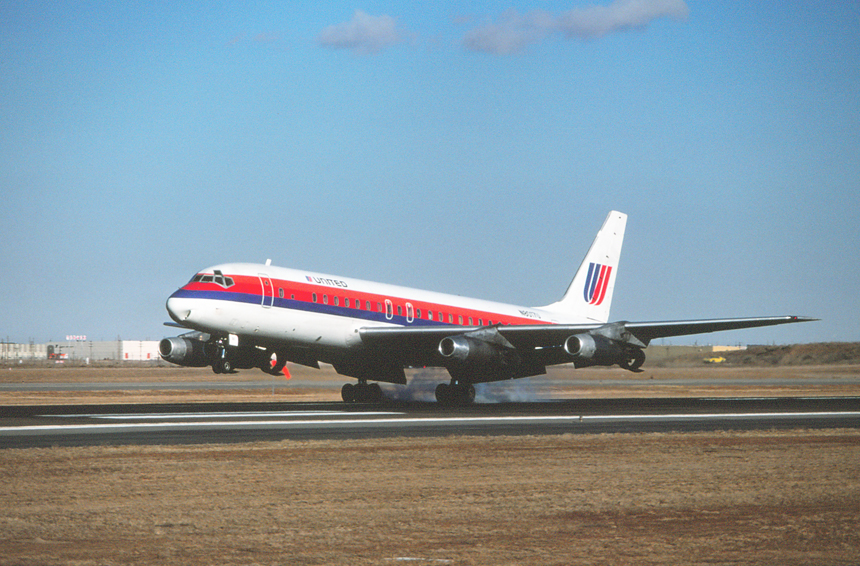
| December
1976 As a launch customer for the Douglas DC-8, United Airlines received its first DC-8-11 in May 1959. Initial performance wasn't as predicated even with water-injected engine takeoffs. United upgraded their initial -11s to -12 with extended wingtips, leading edge slots and upgraded takeoff weights. These airframes were again upgraded to -21 standards with newer JT4A-9 turbojet engines. These early, modified Douglas DC-8s continued to be used by United well into the 1970s, including this example, N8017U, a Douglas DC-8-21, touching down on Runway 26 Left and wearing the new Landor colors. |
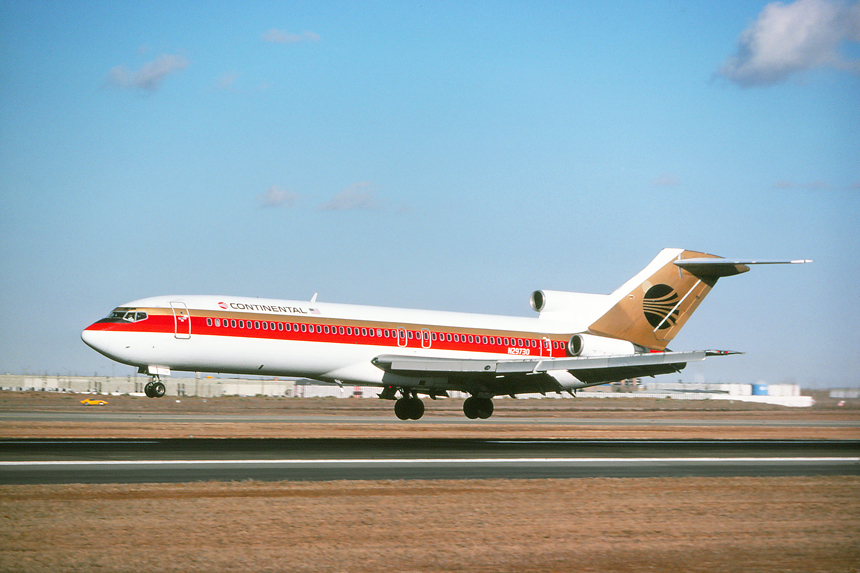
| December
1976 From Denver during 1976, Continental was serving fifteen cities with the Boeing 727 including; Albuquerque, Kansas City, New Orleans, Ontario, and Wichita. Seen about to touch-down on Runway 26 Left during an early evening arrival is N29730, a Boeing 727-224, delivered new to the airline in October 1973. |

|
December 1976 United Airlines "stretch" Douglas DC-8s were used on trunk routes from Denver including services to Los Angeles, Milwaukee, Portland, and Washington-Dulles, however the aircraft was used on many city pairs on services from the "Mile High" city. With the new Saul Bass tri-colors reflecting nicely during an early winter morning arrival, N8089U, a Douglas DC-8-61 is seen on short final to Runway 26 Left. |
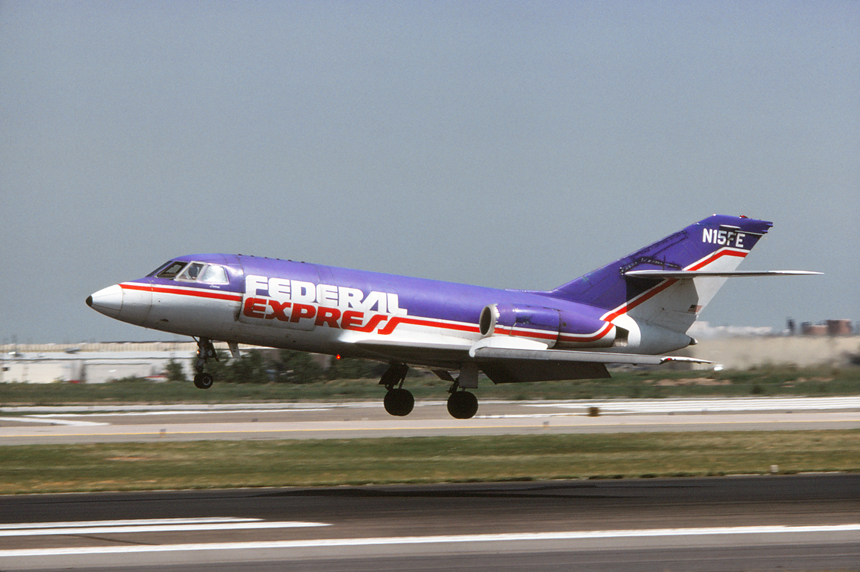
| August
1977 Overnight package carrier Federal Express started operations in 1973, flying a fleet of French made converted Dassault Falcon freighters across the East and Midwest. Within a few years Federal Express had expanded operations to the Rocky Mountain and West Coast regions including services to Denver-Stapleton from its Nashville cargo hub. Seen in flare for landing on Runway 26 Left on a morning arrival is N15FE "Donna," a Dassault Falcon-20DC. |
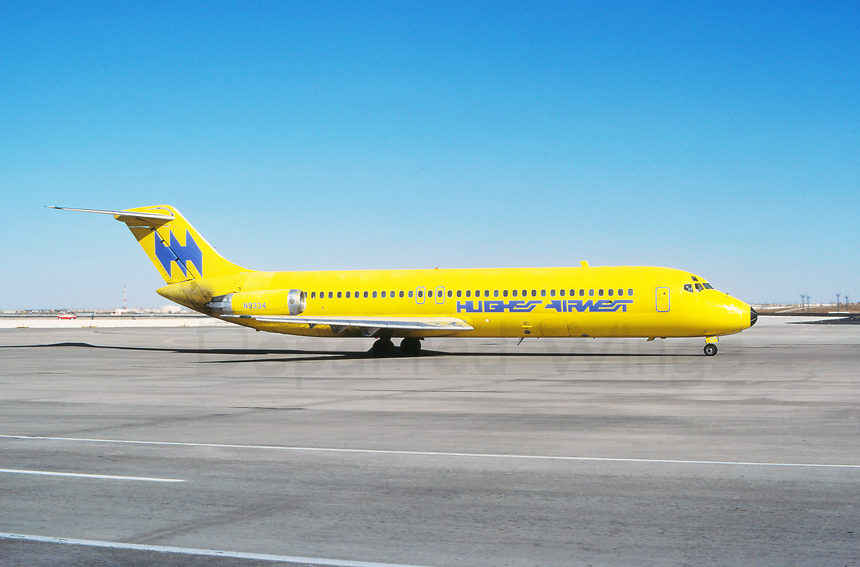
|
August 1977 One of the major airports in the west that had yet to be served by growing regional airline Hughes Airwest was Denver-Stapleton. Predecessor Pacific Air Lines had petitioned the Civil Aeronautics Board (CAB) from before 1959 to secure rights to Denver to no avail. Finally in early 1977, Hughes Airwest was granted permission to serve Denver from both Salt Lake City and Las Vegas in competition with hometown airline Frontier Airlines. Hughes Airwest would eventually add services from Denver to Boise, Idaho Falls, and Burbank before its purchase by Republic Airlines in 1980. Seen taxiing away from the terminal for an afternoon departure and wearing is namesake "yellow banana" color scheme is N9334, a Douglas DC-9-31, originally delivered to AirWest in July 1968. |
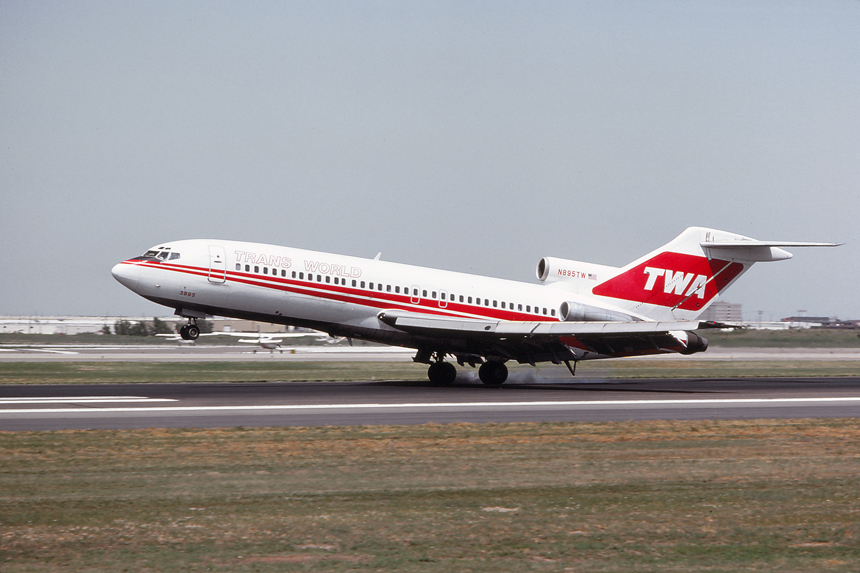
| August
1977 In February 1975 Trans World Airlines (TWA) introduced a new color scheme replacing the infamous "Twin Globes" and the "Star Stream" logos. The new scheme, kept the Trans World "red" used previously, and boldly displayed TWA on the tail within a red rhombus and two wide stripes along the fuselage along with the early open block titles adjacent to the forward passenger doors. Caught touching down on Runway 26 Left is N895TW, a Boeing 727-31C. |

|
September
1977 Aspen Airways continued to provide a vital air-link between the Rocky Mountain resort destination Aspen, and Denver, Colorado and in 1973 upgraded its piston aircraft to new turboprop standards. With delivery of the re-engined Convair CV-580, the small airline was able to increase speed and comfort on the sometimes turbulent 45-minute flight to Aspen. Seen having just touched down on Runway 26 Left after an afternoon arrival from Aspen is N73126, a Convair CV-580. |
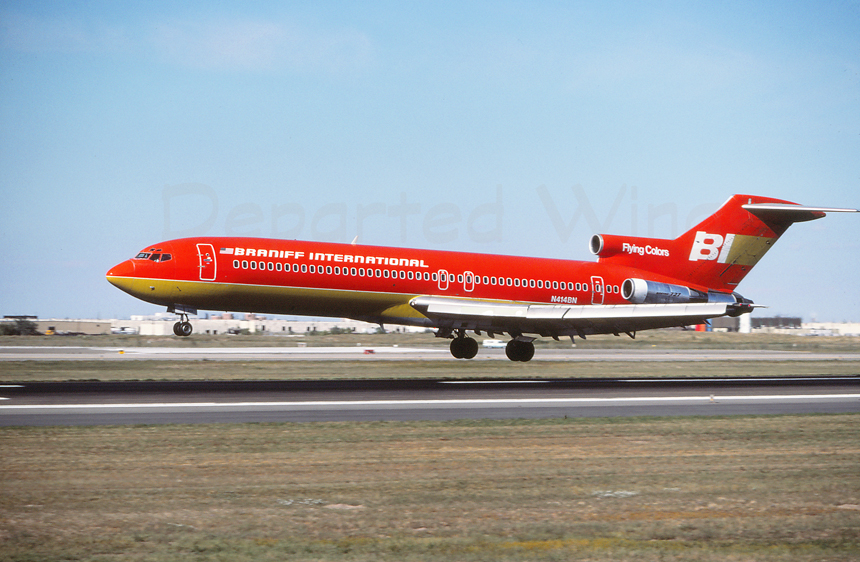
|
September 1977 Braniff International developed a fleet standardization plan in 1971 with the Boeing 727 used on domestic services, the Douglas DC-8 on Latin and South American flights and the Boeing 747 to Hawaii. An image refresh was also completed for witch design agency Harper and George introduced a two-tone colors scheme in what became known as "Flying Colors." Seen just about to touch-down on Runway 26 Right and wearing the "Red/Aztec Gold" colors is N414BN, a Boeing 727-227. |
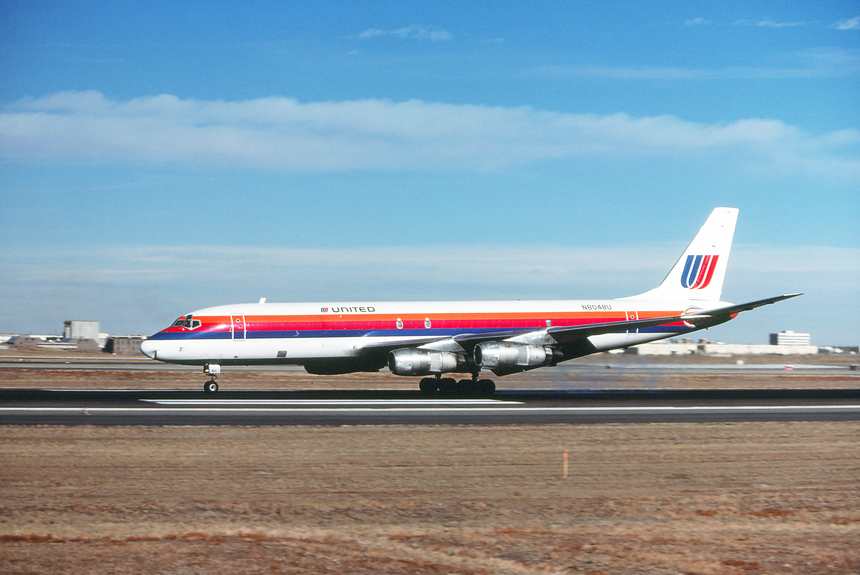
| December
1977 United Airlines' original Douglas DC-8s having been in service for over fifteen years, started being slowly replaced with newer Douglas DC-10s, Boeing 727s, and Boeing 737s during the 1970s. United, which operated a large air cargo division took advantage of the still usable airframes and converted many of the "legacy" DC-8s into all freighter versions. Having just touched down and rolling out on Runway 26 Left is N8048U, a Douglas DC-8-54AF "Jet Trader." |
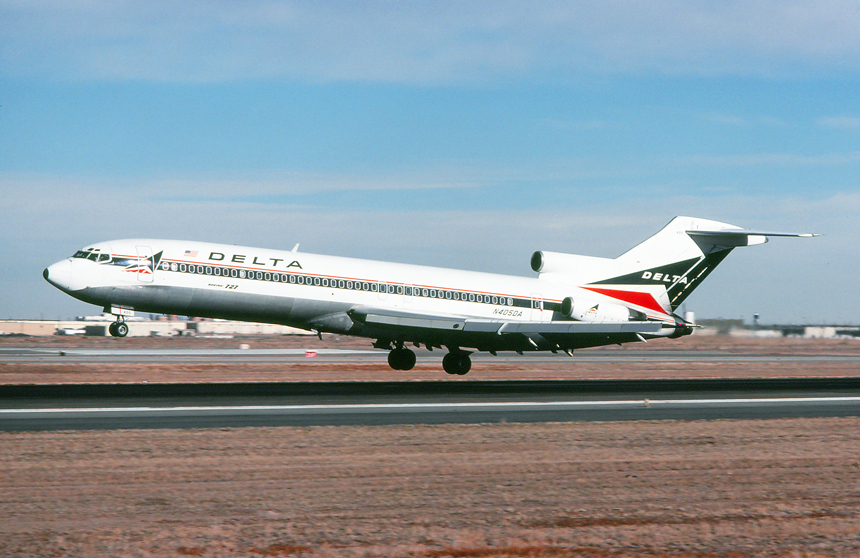
| December
1977 Delta Airlines received approval to start service between Atlanta and Denver in July 1977 and became the first airline to inaugurate non-stop service between the two cities. As an important destination in the West, no less then five daily departures were scheduled using the Boeing 727, Douglas DC-8, and even the wide-body Lockheed L-1011 on the route. Seen about to touch down on Runway 26 Left during an early morning arrival from Atlanta is N405DA, a Boeing 727-232, delivered new to the airline on November 12, 1975. |
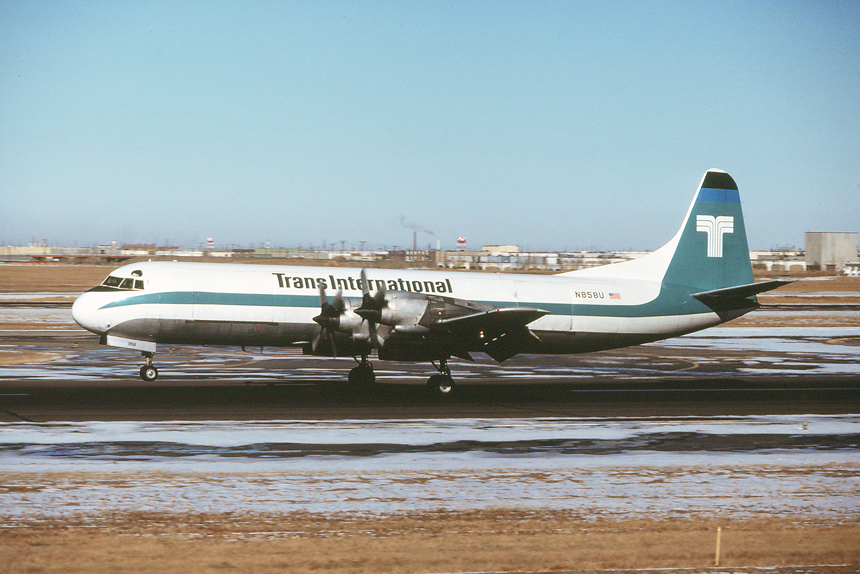
| January
1978 As one of the largest supplemental carriers in the United States, Los Angeles Air Service was renamed Trans International Airlines in 1960 to better reflect its growing business. With an emphasis on military charters, Trans International used a variety of aircraft including the Douglas DC-8, Douglas DC-10 and Lockheed L-188 Electra on worldwide passenger and cargo charters. Seen having just touched down on Runway 26 Left during a cargo charter flight is N858U, a Lockheed L-188C(F) Electra originally delivered to KLM Royal Dutch Airlines in 1960, and taken up by Trans International in December 1976. |
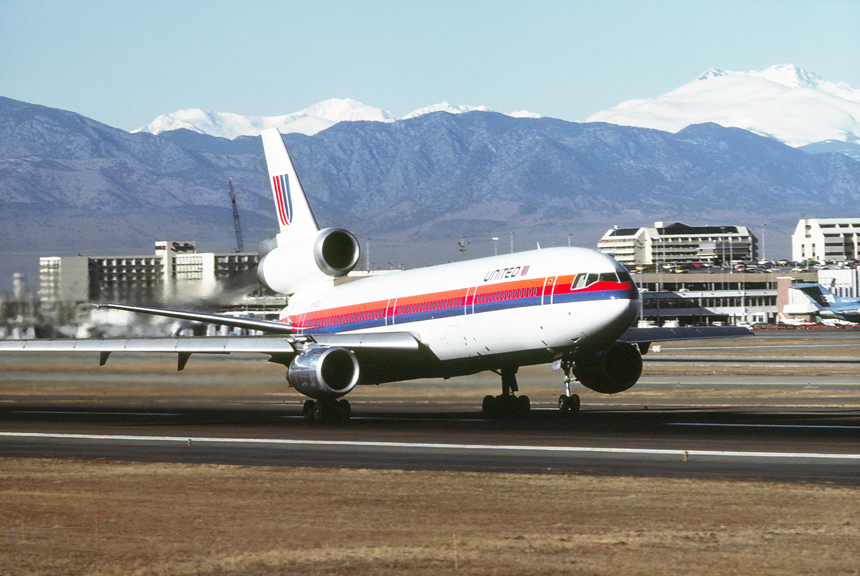
| January
1978 Denver-Stapleton had on of the most scenic vistas for an airport, especially during the winter when the snow covered Rocky Mountains presented a stunning backdrop to the south runways. Seen rotating for takeoff on Runway 8 Right at the Vr callout and framed by the majestic Rockies is N1812U, a Douglas DC-10-10, delivered new to United Airlines in may 1972. |
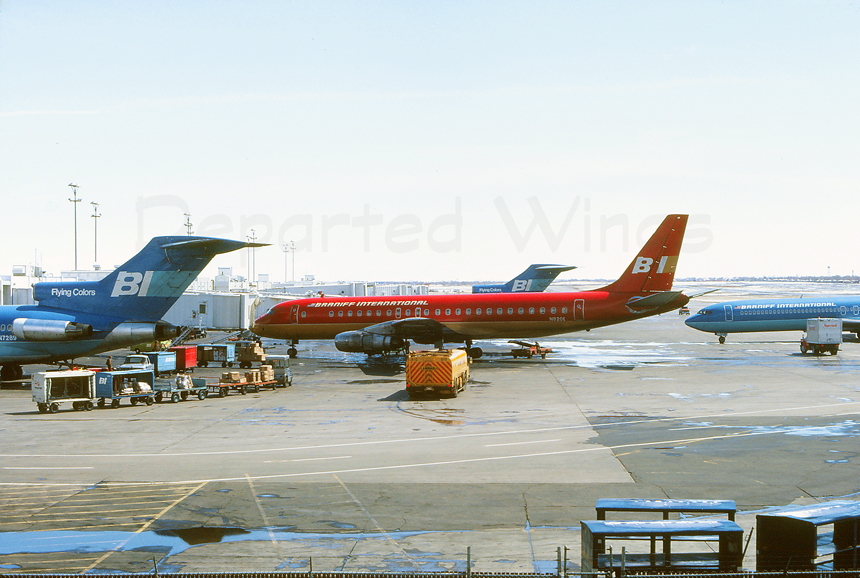
| April
1979 After airline deregulation, Braniff International Airways expanded services at Denver adding flights to both Salt Lake City and Reno, resulting in six destinations served with twenty daily departures including ten each day to Dallas-Ft. Worth using both the Douglas DC-8 and Boeing 727. Proudly representing the "Flying Colors" on a cold ramp is N820E, a Douglas DC-8-51, originally with Delta Air Lines and purchased by Braniff in July 1977. |
Back to: The Airports